There are millions of songs out there that include guitar in them, but only a small subset of those songs have guitar riffs that, once you hear them, you can’t get them out of your head.

Below, we’ll share some of these songs and the best guitar riffs of all time, along with some tips on how to play them.
Table of Contents
- 1. Whole Lotta Love by Led Zeppelin
- 2. Still Loving You by Scorpions
- 3. Sweet Child O’Mine by Guns ‘N’ Roses
- 4. You Shook Me All Night by AC/DC
- 5. Back In Black by AC/DC
- 6. Ain’t Talkin Bout Love by Van Halen
- 7. Smoke On The Water by Deep Purple
- 8. Every Breath You Take by The Police
- 9. Layla by Derek and Dominoes
- 10. Crazy Train by Ozzy Osbourne
- 11. How Soon Is Now by The Smiths
- 12. Hold The Line by Toto
- 13. Down Down by Status Quo
- 14. Iron Man by Black Sabbath
- 15. Money For Nothing by Dire Straits
- 16. Satisfaction by The Rolling Stones
- 17. You Really Got Me by The Kinks
- 18. Learn To Fly by Foo Fighters
- 19. Money by Pink Floyd
- 20. Take On Me by A Ha
- 21. Ziggy Stardust by David Bowie
- 22. Thunderstruck by AC/DC
- 23. Purple Haze by The Jimi Hendrix Experience
- 24. Beat It by Michael Jackson
- 25. Motorcycle Emptiness by The Manic Street Preachers
- 26. Born To Be Wild by Steppenwolf
- 27. 20th Century Boy by T.Rex
- 28. Day Tripper by The Beatles
- 29. Do I Wanna Know by Arctic Monkeys
- 30. Scar Tissue by Red Hot Chilli Peppers
- 31. Enter Sandman by Metallica
- 32. Jump by Van Halen
- 33. Johnny B Goode by Chuck Berry
- 34. Eye Of The Tiger by Survivor
- 35. Spirit Of Radio by Rush
- 36. Message In The Bottle by The Police
- 37. Living On a Prayer by Bon Jovi
- 38. Stairway To Heaven by Led Zeppelin
- 39. Smells Like Teen Spirit by Nirvana
- 40. La Bamba by Ritchie Valens
- 41. All Right Now by Free
- 42. Wonderful Tonight by Eric Clapton
- 43. Oh Well by Fleetwood Mac
- 44. Paranoid by Black Sabbath
- 45. Sweet Home Alabama by Lynyrd Skynyrd
- 46. The One I Love by Rem
- 47. Sunshine Of Your Love by Cream
- 48. Breaking The Law by Judas Priest
- 49. Seven Nation Army by The White Stripes
- 50. Owner Of a Lonely Heart by Yes
- 52. Hells Bells by AC/DC
- 53. One Vision by Queen
- 54. Carry On Wayward Son by Kansas
- 55. Pretty Vacant by Sex Pistols
- 56. Alive by Pearl Jam
- 57. No Surprises by Radiohead
- 58. Master Of Puppets by Metallica
- 59. Hocus Pocus by Focus
- 60. Fly Away by Lenny Kravitz
- 61. Cigarettes and Alcohol
- 62. House Of The Rising Sun by The Animals
- 63. No One Knows by Queens Of The Stone Age
- 64. Gyöngyhajú Lány by OMEGA
- 65. I Can’t Explain by The Who
- 66. Seek And Destroy by Metallica
- 67. Born To Run by Bruce Springsteen
- 68. Cemetery Gates by Pantera
- 69. Fools Gold by The Stone Roses
- 70. Billie Jean by Michael Jackson
- 71. Apache by The Shadows
- 72. Hey Joe by Jimi Hendrix
- 73. Run To You by Bryan Adams
- 74. A Whiter Shade Of Pale by Procol Harum
- 75. Stay With Me by Faces
- 76. Sweet Dreams by Marilyn Manson
- 77. Atomic by Blondie
- 78. Ace Of Spades by Motorhead
- 79. Life In The Fast Lane by Eagles
- 80. Zombie by The Cranberries
- 81. Milk And Alcohol by Dr. Feelgood
- 82. Black Night by Deep Purple
- 83. Spoonman by Soundgarden
- 84. Cocaine by Eric Clapton
- 85. Should I Stay Or Should I Go by The Clash
- 86. Nothing Else Matters by Metallica
- 87. Killing In The Name Of by Rage Against The Machine
- 88. Rock You Like a Hurricane by Scorpions
- 89. Walk This Way by Aerosmith
- 90. Highway To Hell by AC/DC
- 91. Sharp Dressed Man by ZZ Top
- 92. Just Like Heaven by The Cure
- 93. Mannish Boy by Muddy Waters
- 94. Rainbow In The Dark by Dio
- 95. Peter Gunn by Duane Eddy
- 96. Don’t Fear The Reaper by Blue Oyster Cult
- 97. Misirlou by Dick Dale
- 98. Smooth by Carlos Santana
- 99. Song 2 by Blur
- 100. Californication by Red Hot Chili Peppers
1. Whole Lotta Love by Led Zeppelin
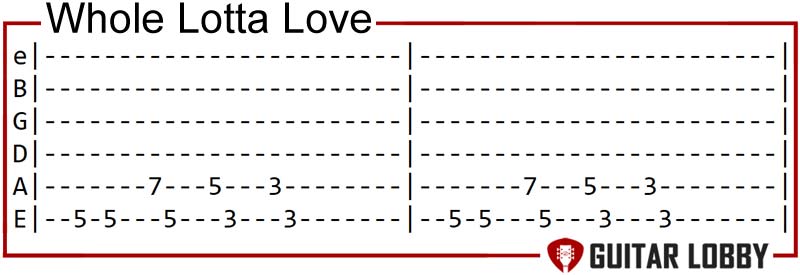
Tabs: See Whole Lotta Love by Led Zeppelin Tabs Here
“Whole Lotta Love” by Led Zeppelin, released in 1969, incorporates experimental and psychedelic elements that add a unique and avant-garde dimension to the song. This track played a pivotal role in defining hard rock and heavy metal, influencing countless musicians. Its enduring popularity underscores its timeless status in rock music history.
Tips to play:
The song is typically played in open E tuning, but you can play it in standard tuning with a capo on the third fret. The main riff includes a slide on the low E string. Work on sliding smoothly to get the right sound. Also, to capture the song’s powerful tone, use a good amount of distortion on your amplifier and experiment with the amp settings.
2. Still Loving You by Scorpions
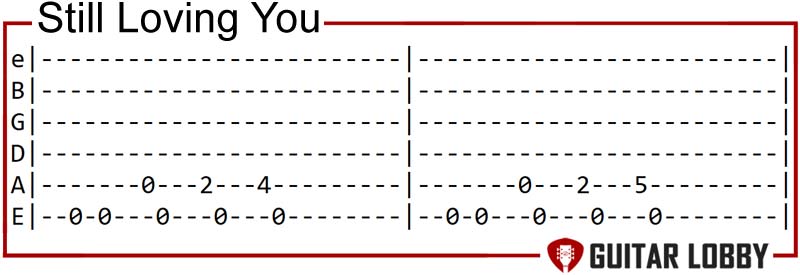
Tabs: See Still Loving You by Scorpions Tabs Here
“Still Loving You” by Scorpions starts with a moving and memorable guitar intro by Matthias Jabs that sets an emotional tone. Jabs’ soulful guitar solo is notable, a signature of Scorpions’ style. The band’s use of layered guitars and an intricate bridge section further highlights their musicianship. Dynamic shifts from tender verses to a soaring chorus enhance engagement. With timeless appeal and emotional depth, this song is a classic in rock music.
Tips to play:
Consider using multiple guitar tracks to replicate the layered sound of the original recording. You can play the primary chords while adding melodic embellishments and arpeggios to mimic the richness of the song. Practice with a metronome to improve timings and sync with rhythm changes.
3. Sweet Child O’Mine by Guns ‘N’ Roses
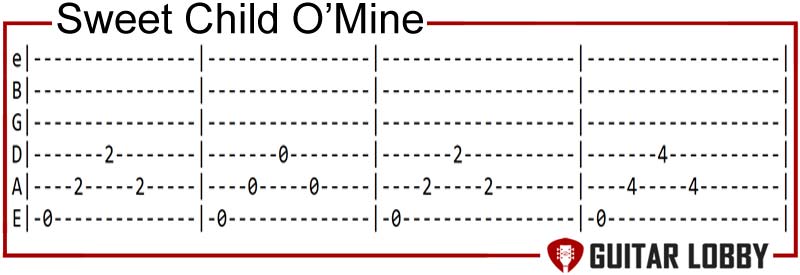
Tabs: See Sweet Child O’Mine by Guns ‘N’ Roses Tabs Here
“Sweet Child O’ Mine” features an iconic opening riff played by Slash, widely recognized as one of rock’s greatest. Slash’s intricate and precise guitar work, blending fast picking, string bending, and sliding, showcases his exceptional skill. The song seamlessly blends rock, blues, and complex rock elements and contributed to the revitalization of hard rock and heavy metal in the late 1980s and early 1990s.
Tips to play:
Familiarize yourself with the chord progressions that include C, G, D, and Em. Begin by learning and mastering the iconic opening riff, the song’s most recognizable part. For easy playing, break the song into smaller sections and practice slowly at first. Gradually increase your speed and focus on the bends, slides, and vibrato.
4. You Shook Me All Night by AC/DC
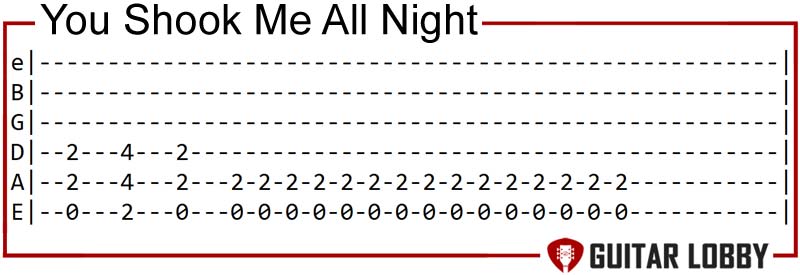
Tabs: See You Shook Me All Night by AC/DC Tabs Here
“You Shook Me All Night Long” features one of rock history’s most iconic and instantly recognizable guitar riffs, courtesy of Angus Young. Angus’s scorching guitar work drives the song’s opening. Also, the relentless rhythm guitar played by Malcolm Young complements Angus’s lead riff perfectly. The song’s guitar riff has become a cultural reference point, frequently used in movies, commercials, and sporting events.
Tips to play:
Start with Angus Young’s iconic main riff. It’s the heart of the song. Use palm muting to add that characteristic crunch to your guitar sound. Additionally, the song primarily uses power chords (5th chords), a classic rock staple. Focus on these power chord shapes (e.g., A5, D5, G5, etc.) and practice changing between them smoothly.
5. Back In Black by AC/DC
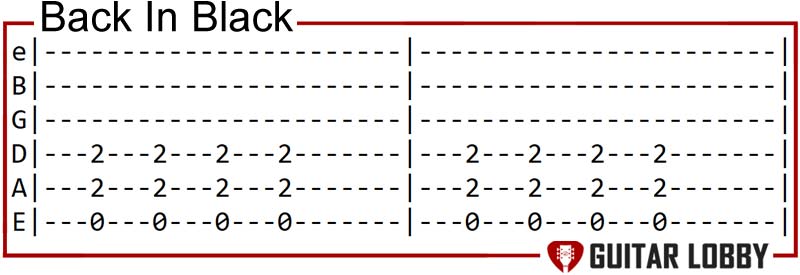
Tabs: See Back In Black by AC/DC Tabs Here
“Back in Black” is simple yet incredibly powerful and catchy, setting the song’s energetic tone, functioning as a memorable intro, and leaving a lasting impression on listeners. The song’s universal appeal spans generations, and it was released as a heartfelt tribute to AC/DC’s late lead singer, Bon Scott. The track’s layered guitar sound, with Angus Young’s lead guitar complemented by Malcolm Young’s rhythm guitar, adds depth. Moreover, its cultural impact in various media reflects its enduring significance.
Tips to play it:
Begin by learning the iconic opening riff, the song’s signature. Employ palm muting to achieve that classic AC/DC crunch in your guitar sound and capture the groove. Additionally, learn smooth transitioning with power chords – E5, D5, and A5.
6. Ain’t Talkin Bout Love by Van Halen
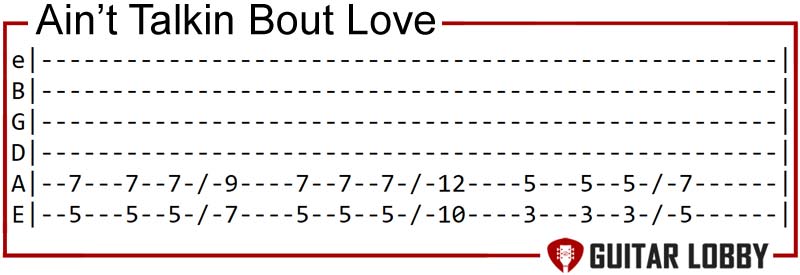
Tabs: See Ain’t Talkin Bout Love by Eddie Van HalenTabs Here
“Ain’t Talkin’ ‘Bout Love” features an instantly recognizable and iconic guitar riff from Eddie Van Halen. This riff, characterized by rapid hammer-ons and pull-offs, is energetic and catchy, setting the song’s tone. Eddie Van Halen’s groundbreaking tapping technique makes it even more unique, where he uses both hands on the fretboard, influencing countless guitarists across genres. The song also incorporates harmonics, adding an ethereal quality.
Tips to play it:
Focus on the hammer-ons and pull-offs to replicate Eddie’s signature sound. Utilize palm muting to control the sustain and create a staccato effect when necessary. Also, use a distorted guitar tone by adjusting your amplifier to achieve the song’s gritty and aggressive sound. Experiment tapping with both hands on the fretboard.
7. Smoke On The Water by Deep Purple
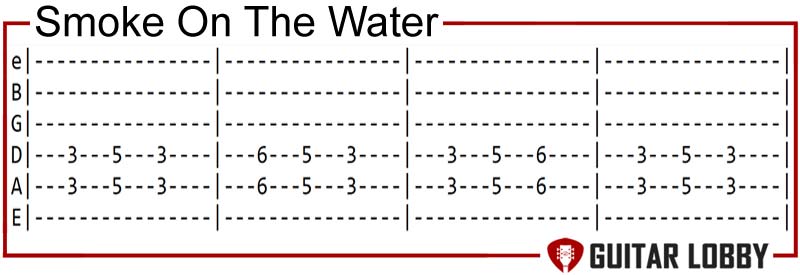
Tabs: See Smoke On The Water by Deep Purple Tabs Here
“Smoke On The Water” features one of the most iconic and instantly recognizable guitar riffs in rock history, courtesy of Ritchie Blackmore. Beyond its musical prowess, the song holds historical significance, recounting an actual fire at the Montreux Casino in Switzerland. Its simplicity, layered guitar work, and lasting cultural impact make it a staple for guitar songs.
Tips to play it:
Start by mastering the iconic main riff, played on the lower strings. Use alternate picking (down-up-down-up) to maintain a consistent rhythm and a clean sound. Avoid downstrokes or upstrokes for a smoother performance. Also, using palm muting on the lower strings to recreate the muted, chunky sound. Rest your palm lightly on the strings near the bridge while strumming.
8. Every Breath You Take by The Police
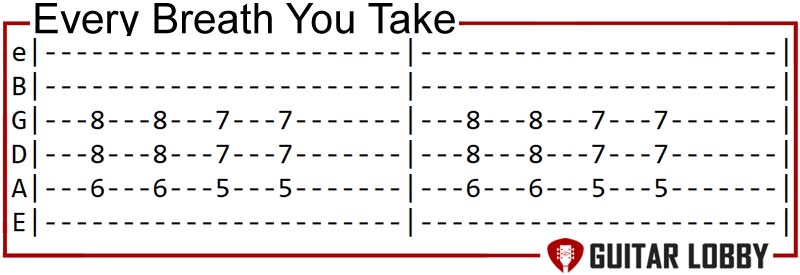
Tabs: See Every Breath You Take by The Police Tabs Here
“Every Breath You Take” highlights an instantly recognizable guitar riff played by Andy Summers, characterized by its simplicity and melodic charm. It adds an intriguing layer to the song’s lyrics, which, although often perceived as a love ballad, carry an undertone of obsession and possessiveness. With layered arrangements, lasting popularity, and critical acclaim, it has received multiple Grammy Awards and remains an emotionally complex classic in popular music.
Tips to play it:
The song’s main riff is built around a few chords: A, F#m, D, and E. Practice transitioning smoothly between these chords as you play the riff. The picking pattern for the main riff involves arpeggiating the chords. Practice picking each chord string from bass notes, then moving upwards.
9. Layla by Derek and Dominoes
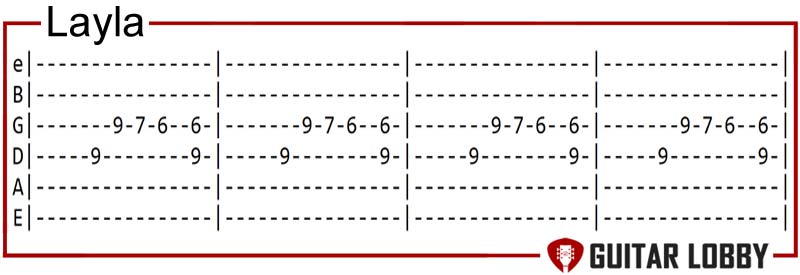
Tabs: See Layla by Derek and Dominoes Tabs Here
“Layla” is best known for Eric Clapton’s iconic guitar riff that is instantly recognizable. The track is a masterful blend of blues and rock, showcasing Clapton’s exceptional guitar skills. The song’s inspiration, rooted in Clapton’s unrequited love for Pattie Boyd, lends it emotional intensity. Notably, “Layla” features dual guitar work with Duane Allman, resulting in a rich and harmonious sonic experience.
Tips to play it:
In the intro, Clapton uses a glass slide to achieve a smooth, sliding sound. Experiment with a slide to replicate this effect. Utilize palm muting to create the characteristic percussive sound in the main riff. Also, maintain a steady tempo throughout the song, particularly during the main riff. Practice with metronomes to improve your timing.
10. Crazy Train by Ozzy Osbourne
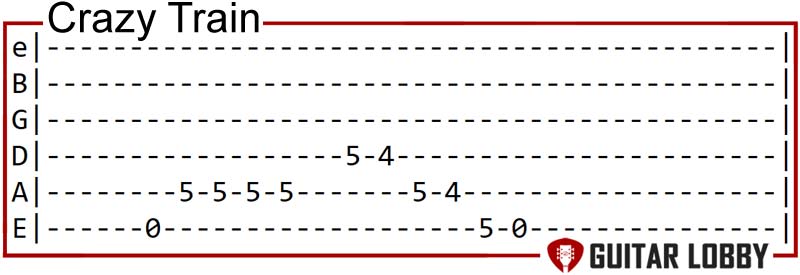
Tabs: See Crazy Train by Ozzy Osbourne Tabs Here
“Crazy Train” has an iconic guitar riff known for its electrifying energy and power, serving as the song’s driving force. Rhoads’ guitar work showcases his technical mastery with fast-paced and precise palm-muted picking. The song’s arrangement is complex, with dynamic shifts and a memorable guitar solo. Moreover, it holds historical significance, influencing the heavy metal sound of the 1980s and leaving a lasting cultural impact in various media.
Tips to play it:
Pay close attention to the palm-muted picking, which adds to the riff’s signature sound. Use downstrokes to get a powerful, chugging sound for the palm-muted parts of the riff. It’s essential for capturing the song’s energy. You can also use a distorted tone for the heavy metal sound.
11. How Soon Is Now by The Smiths
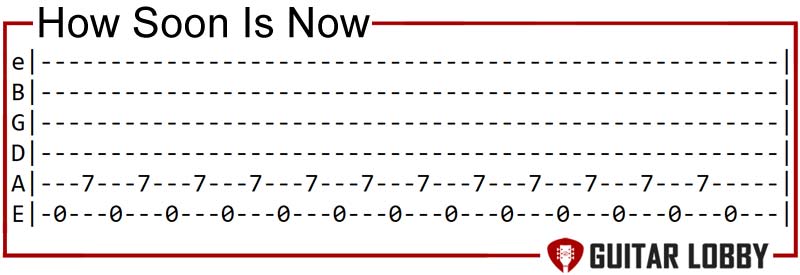
Tabs: See How Soon Is Now by The Smiths Tabs Here
“How Soon Is Now” is known for its unique and innovative guitar riff, expertly crafted by Johnny Marr. Additionally, the track defies genre boundaries, blending elements of alternative, post-punk, and indie rock, contributing to its timeless appeal. Its cultural significance and emotionally charged lyrics exploring themes of isolation and longing further enhance its status as an iconic piece in alternative and indie music.
Tips to play it:
Johnny Marr combined a tremolo arm and chorus to achieve the song’s distinctive sound. Familiarize yourself with these effects if you have them on your guitar or pedalboard. Also, remember that the riff is essentially a series of chord voicings played in arpeggiated. Pay attention to the timing and dynamics of your picking.
12. Hold The Line by Toto
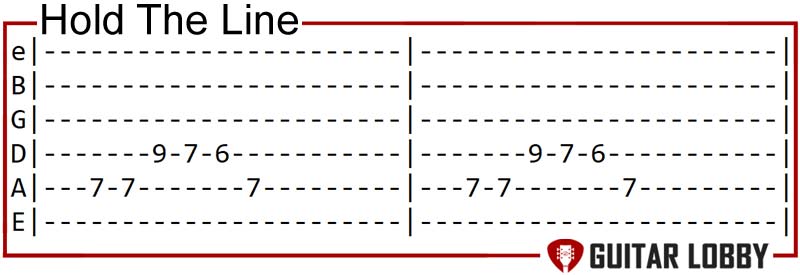
Tabs: See Hold The Line by Toto Tabs Here
“Hold The Line” highlights Steve Lukather’s iconic guitar riff, contributing to the song’s upbeat and catchy melody. His guitar work stands out for its precision, melodic sensibility, and expressive solos that convey deep emotion. The harmonized guitar parts and instrumental bridge add a distinct richness to the song.
Tips to play it:
Pay close attention to the timing and rhythm of the riff. This song has a distinctive groove, so groove along with it. Familiarize yourself with the chord voicings used in the music. The riff incorporates power chords, so practice your power chord shapes. Also, when playing the riff, use your fretting hand to mute any strings that shouldn’t ring out. This will help you keep the riff clean.
13. Down Down by Status Quo
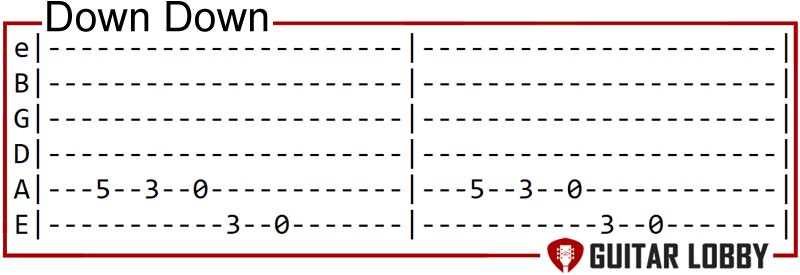
Tabs: See Down Down by Status Quo Tabs Here
“Down Down” highlights a remarkable guitar riff masterfully played by Francis Rossi and Rick Parfitt. It is a prime example of boogie rock, a genre pioneered by Status Quo, with its rhythmic and bluesy guitar style. What sets it apart is the dual-guitar attack, innovative use of open tuning (open D), and extended jam sessions in live renditions.
Tips to play it:
The song incorporates slide-like sounds in the riff. You can use a slide or your fingers to create this effect. Experiment with sliding up and down the strings to mimic the sound. Boogie rock relies heavily on a steady, pulsating rhythm. Practice strumming or picking with a strong sense of timing and groove. Try replicating the dual-guitar attack.
14. Iron Man by Black Sabbath
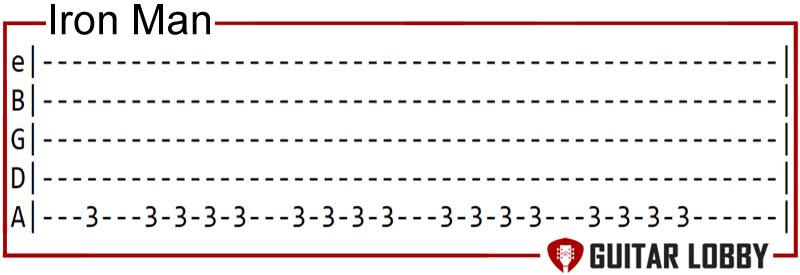
Tabs: See Iron Man by Black Sabbath Tabs Here
“Iron Man” is recognized for Tony Iommi’s heavy and distinctive guitar riff in the song’s intro, which is legendary in rock music. This track is a cornerstone of the heavy metal genre, defined by its rich, distorted guitar sound and dark atmosphere. It’s worth noting that Iommi used a pioneering technique of dropped tuning (C# tuning) to achieve the song’s low and heavy sound, a method that became synonymous with Black Sabbath’s style. The music stands out lyrically with its narrative of a time traveler witnessing the apocalypse and returning to warn humanity.
Tips to play it:
Focus on mastering the main guitar riff. Tony Iommi uses downstrokes to achieve a heavy sound, so practice it with the main riff.
15. Money For Nothing by Dire Straits
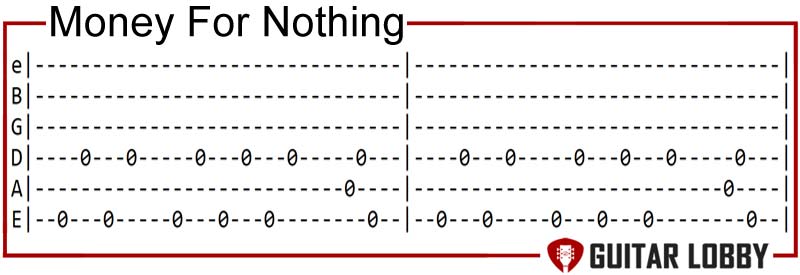
Tabs: See Money For Nothing by Dire Straits Tabs Here
“Money For Nothing” showcases Mark Knopfler’s guitar riff, distinguished by its fingerpicking technique and clean guitar tone. The song also stands out for its innovative use of guitar effects, notably the distinctive “sting” sound created by Knopfler’s technique and compression effects. Additionally, the song offers a satirical commentary on the music industry and the rock star lifestyle, with guest vocals by Sting adding a unique layer to the composition.
Tips to play it:
Develop your fingerpicking skills, as this song relies heavily on fingerstyle playing. Practice picking individual strings with your thumb and fingers to achieve clarity and precision. Use a clean guitar tone to replicate the song’s sound accurately. Avoid excessive distortion or overdrive, and learn the chord shapes. This is easily one of the best guitar riffs of all time and it’s a ton of fun to play.
16. Satisfaction by The Rolling Stones
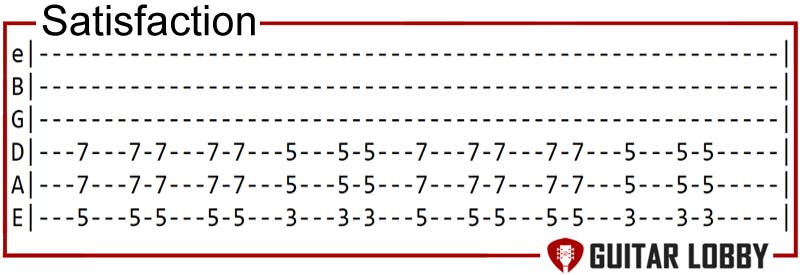
Tabs: See Satisfaction by The Rolling Stones Tabs Here
“Satisfaction” serves as a defining moment in the history of rock ‘n’ roll, symbolizing the rebellious spirit of the genre. The song is a cultural touchstone of the 1960s, reflecting the counterculture movement and youth rebellion. The song features a legendary riff by Keith Richard at the beginning of the song, making it a chart-topping success.
Tips to play it:
Using palm muting while strumming or picking, capture the song’s signature “chugging” sound. Rest your palm lightly on the strings near the bridge to dampen the sound slightly. The riff has a staccato, punchy feel. Ensure precise timing of the notes, and use short, controlled strums or picks. Also, practice with a metronome or drum track to maintain the groove.
17. You Really Got Me by The Kinks
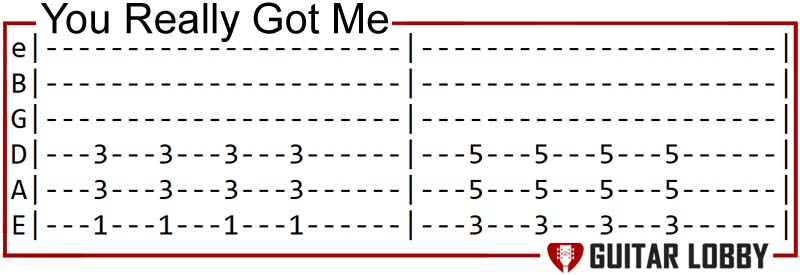
Tabs: See You Really Got Me by The Kinks Tabs Here
“You Really Got Me” is known for Dave Davies’ guitar riff in the song, which is nothing short of groundbreaking, with its raw, distorted power chords and aggressive strumming. It is often regarded as a historical precursor to heavy metal. Despite its simplicity, the riff remains incredibly powerful and timeless.
Tips to play it:
The main riff is built on power chords. Practice and memorize the power chord shapes for E5, G5, and A5, which are the core chords of the song. Use a distortion or overdrive pedal to capture the song’s gritty sound. Experiment with the level of distortion to match the original recording. Additionally, strum the chords with an aggressive downstroke to replicate the energy; don’t hold back!
18. Learn To Fly by Foo Fighters
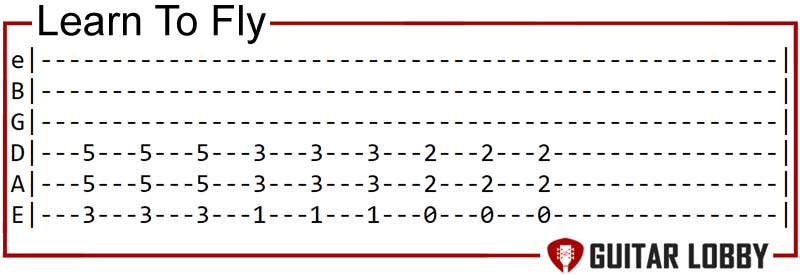
Tabs: See Learn To Fly by Foo Fighters Tabs Here
“Learn to Fly” highlights Dave Grohl’s guitar riff in the song, boasting a blend of simplicity and melodic charm that sets it apart. It transitions between verses and chorus effortlessly, contributing to the song’s seamless flow and energy. Lyrically, the piece explores themes of self-discovery and liberation, resonating with a broad audience. This anthem’s groove creates an uplifting atmosphere, making it a live performance favorite.
Tips to play it:
Pay close attention to the song’s rhythm and dynamics. The riff should be played with a consistent and rhythmic strumming or picking pattern. Depending on your preference, you can strum the chords or pick the individual notes of the riff. Experiment with both techniques to see which suits your style best.
19. Money by Pink Floyd
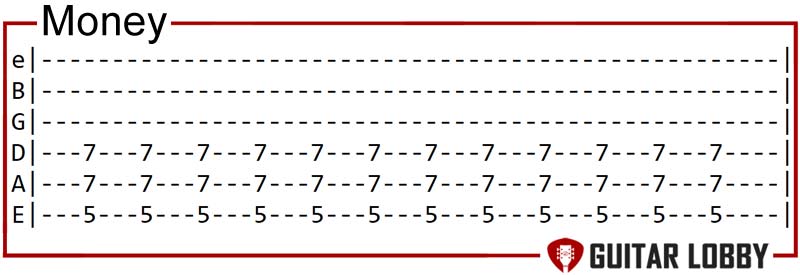
Tabs: See Money by Pink Floyd Tabs Here
“Money” has David Gilmour’s guitar work that opens with an instantly recognizable and unforgettable riff, setting the song’s tone. Notably, the track employs an unconventional 7/4 time signature, adding a layer of complexity to its structure. The track incorporates unique sound effects like cash registers and coins, enhancing its thematic elements. Additionally, Roger Waters’ bassline contributes a funky groove, while thought-provoking lyrics critique money’s societal role.
Tips to play it:
David Gilmour uses a delay pedal to achieve the distinctive echoing sound in his guitar parts. Experiment with delay settings to replicate this effect. Focus on capturing the expressive bends, slides, and vibrato that define his style. Use a clean and slightly overdriven tone for this section of this song.
20. Take On Me by A Ha
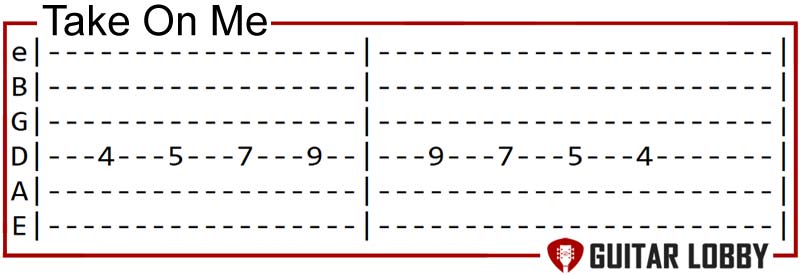
Tabs: See Take On Me by A Ha Tabs Here
“Take On Me” features a memorable guitar riff in its instrumental sections, adding a touch of rock to its synth-driven melody. What truly sets the song apart is its groundbreaking music video, blending live-action with pencil-sketch animation, making it one of the most innovative visuals of the 1980s. The song’s fame also rests on Morten Harket’s impressive falsetto, showcasing his remarkable vocal range.
Tips to play it:
Use a capo on the second fret to match the song’s key. Employ a rhythmic strumming pattern to match the feel. The song’s melody can be played on the guitar using single notes. Practice playing it on the high E and B strings and switch between chords smoothly and strum to match progressions.
21. Ziggy Stardust by David Bowie
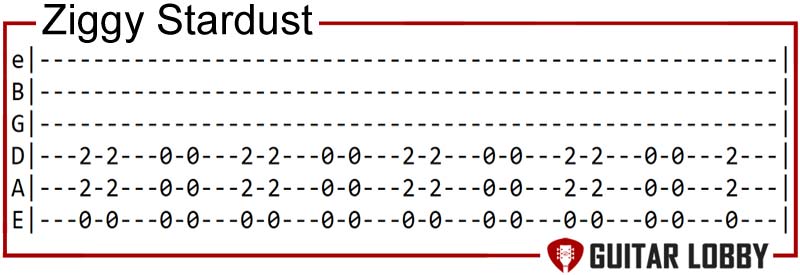
Tabs: See Ziggy Stardust by David Bowie Tabs Here
“Ziggy Stardust” is a quintessential glam rock anthem, characterized by boldness and theatricality, perfectly embodying the genre’s spirit. The song is part of Bowie’s Ziggy Stardust concept album, where the alter ego Ziggy Stardust, a flamboyant rock star, comes to life through the energetic riff. The song left a profound cultural impact, influencing music and fashion trends. In live performances, the piece often featured extended and improvisational versions, further showcasing its significance in Bowie’s repertoire.
Tips to play it:
The song uses barre chords, primarily F# and B. Work on your barre chord technique to ensure clean and clear chord changes. Practice playing softly during verses and building up to a more powerful strumming or picking style during the chorus.
22. Thunderstruck by AC/DC
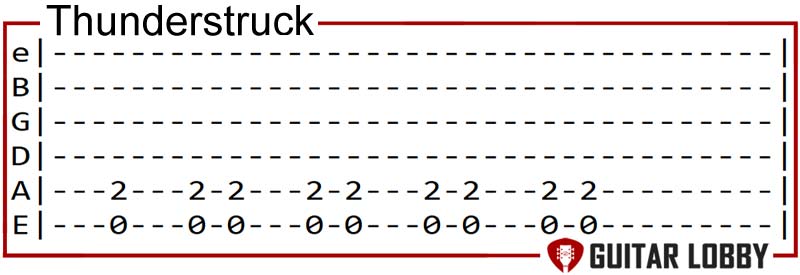
Tabs: See Thunderstruck by AC/DC Tabs Here
“Thunderstruck” is famous for Angus Young’s lightning-fast guitar work that makes the song electrifying and a high-energy anthem for live concerts. In live performances, Angus Young’s skills shine as he extends the guitar solo sections. The alternate picking technique used in the riff showcases Young’s exceptional technical skill, adding to the allure.
Tips to play it:
Break down the main riff into smaller sections and practice each part slowly and accurately. Break down the main riff into smaller sections and practice each piece slowly and accurately. Use your fretting hand to mute unwanted strings to prevent them from ringing out while playing the riff. This is crucial for clarity. Also, start slow and gradually increase the tempo as you progress.
23. Purple Haze by The Jimi Hendrix Experience
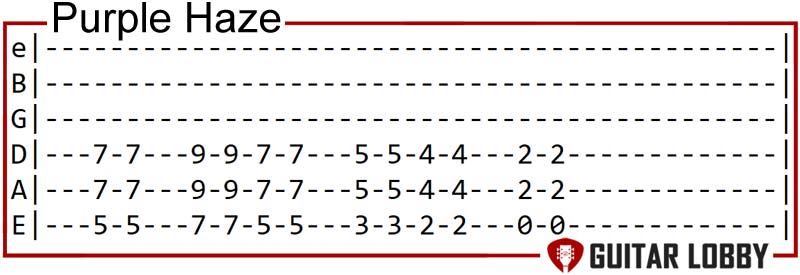
Tabs: See Purple Haze by The Jimi Hendrix Experience Tabs Here
“Purple Haze” opens with one of the most iconic and instantly recognizable guitar riffs in rock history, courtesy of Jimi Hendrix, characterized by its distorted and psychedelic sound, serving as a defining element of the track. Moreover, Hendrix’s innovative use of feedback, notably in the intro, adds a surreal and otherworldly quality to the music. The song’s lyrics are equally intriguing, reflecting the psychedelic spirit of the 1960s.
Tips to play it:
Hendrix often tuned his guitar down a half-step (Eb-Ab-Db-Gb-Bb-Eb). This lower tuning contributes to the song’s unique sound. Start with the iconic riff. Focus on clean and accurate bending and vibrato. Finally, use a fuzz pedal or a distortion pedal to replicate Hendrix’s guitar’s saturated and distorted tone.
24. Beat It by Michael Jackson
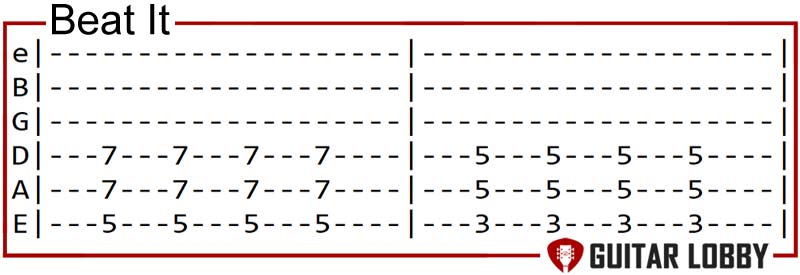
Tabs: See Beat It by Michael Jackson Tabs Here
“Beat It” boasts an iconic guitar solo by the legendary Eddie Van Halen. What makes “Beat It” even more remarkable is its fusion of rock and pop elements, breaking genre boundaries. The song’s influential music video, featuring a choreographed street fight, played a pivotal role in MTV’s early years. Moreover, it carries a meaningful anti-gang message, aligning with Jackson’s socially conscious image.
Tips to play it:
Begin by breaking down the guitar solo into smaller sections. Eddie Van Helen’s guitar solo performances incorporate various techniques, including tapping, bending, vibrato, and slides. Practice these techniques individually to ensure precision. The tapping section is a highlight of the solo. Practice tapping on the fretboard with both hands to develop speed and accuracy.
25. Motorcycle Emptiness by The Manic Street Preachers
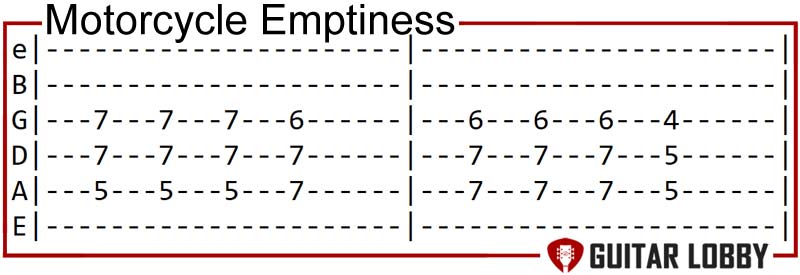
Tabs: See Motorcycle Emptiness by The Manic Street Preachers Tabs Here
“Motorcycle Emptiness” stands out due to the intricate and layered guitar work, with James Dean Bradfield and Richey Edwards crafting a rich sonic tapestry. Its lyrics, exploring themes of alienation and consumerism, add depth to the music. Highly acclaimed upon release, the song remains a fan favorite at live shows and a signature track for the band. Emerging during the Britpop era, it contributed to The Manic Street Preachers’ reputation as a force in British rock.
Tips to play it:
In the original, multiple guitars are playing simultaneously. If playing solo, focus on the most prominent guitar part and capture its melodic essence. Also, the song involves barre chords. Ensure your barre chord technique is strong for precise chord changes.
26. Born To Be Wild by Steppenwolf
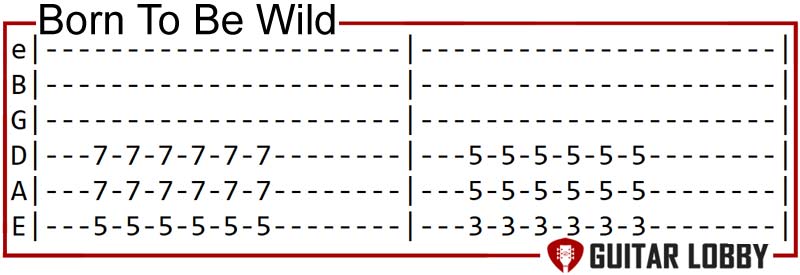
Tabs: See Born To Be Wild by Steppenwolf Tabs Here
“Born To Be Wild” has an iconic and enduring guitar riff, played by Mars Bonfire, symbolizing rock rebellion and freedom. It became an anthem of the counterculture movement in the 1960s and is prominently featured in the classic film “Easy Rider.” This song’s influence on rock music is profound, often cited as an early example of heavy metal and hard rock, helping shape the genre’s trajectory.
Tips to play it:
Begin by focusing on the iconic opening riff, which is played on the low E and A strings. Practice it slowly and accurately to capture the groove. The primary chords used in the song are power chords (fifth chords). Familiarize yourself with these shapes and their positions on the fretboard.
27. 20th Century Boy by T.Rex
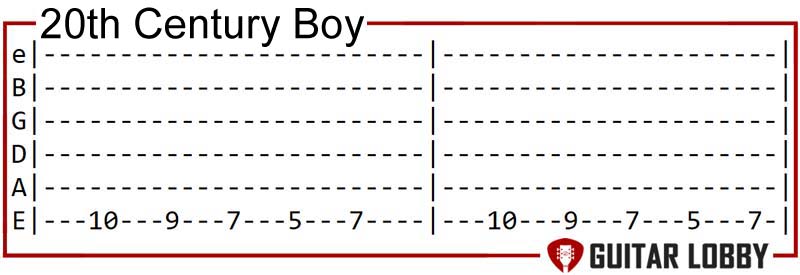
Tabs: See 20th Century Boy by T.Rex Tabs Here
“20th Century Boy” is a quintessential glam rock anthem that embodies the flamboyant glam rock era of the early 1970s, influencing punk rock and alternative rock. Bolan’s charismatic vocals and the riff create a unique and unforgettable sonic experience. With provocative lyrics that capture youthful rebellion, “20th Century Boy” remains a timeless representation of glam rock, inspiring rock musicians.
Tips to play it:
Begin by focusing on the iconic guitar riff. It’s played on the low E string and involves slides and power chords. Practice it slowly and accurately, then gradually increase the tempo. You can use a slide to replicate some of the signature slides in the riff. Use palm muting to add a percussive quality to the riff.
28. Day Tripper by The Beatles
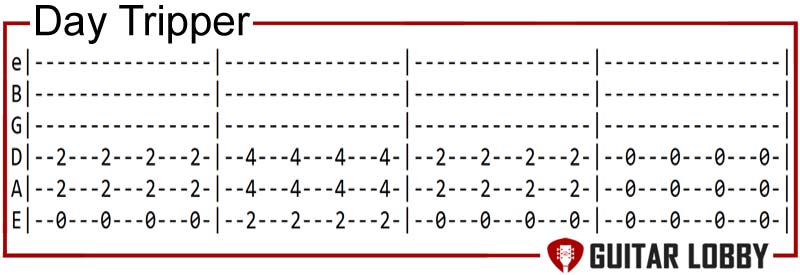
Tabs: See Day Tripper by The Beatles Tabs Here
“Day Tripper” boasts George Harrison’s legendary opening riff, which profoundly influenced the evolution of rock and roll music in the 1960s. Its bluesy and catchy nature adds depth to the track. The song’s lyrics tell the story of a woman leading a double life, adding intrigue and depth to the track. The combination of compelling lyrics and the memorable riff makes it a classic.
Tips to play it:
Begin by learning the iconic opening riff, played by George Harrison. This riff is the song’s defining feature, so take your time to get it right. Focus on finger placement and picking technique. Notice where muted strums or rests are in the song and replicate these to match the original recording’s dynamics.
29. Do I Wanna Know by Arctic Monkeys
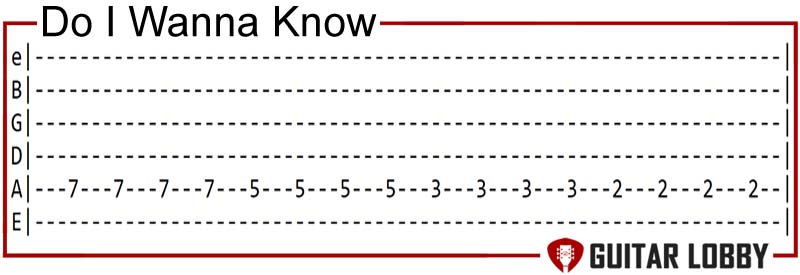
Tabs: See Do I Wanna Know by Arctic Monkeys Tabs Here
“Do I Wanna Know” features a mesmerizing guitar riff characterized by its heavy, sultry tone and repetitive melody, creating a hypnotic atmosphere that perfectly complements the track’s themes of desire and uncertainty. The lyrics delve into the depths of unrequited love, adding emotional depth to the composition, with the music video showcasing visually striking animation that aligns with the song’s mood.
Tips to play it:
Use palm muting to achieve the song’s distinctive muted and percussive sound. This technique is vital for capturing the riff’s character. Also, strum the strings confidently but subtly to create the right mood. In addition to this, focus on proper fretboard positioning to ensure you’re playing the correct notes and maintaining clarity in the riff.
30. Scar Tissue by Red Hot Chilli Peppers
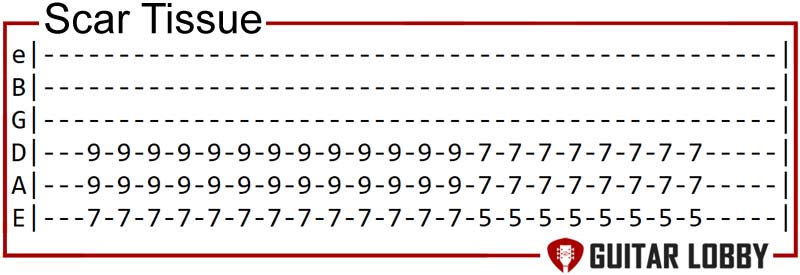
Tabs: See Scar Tissue by Red Hot Chilli Peppers Tabs Here
“Scar Tissue” features a riff that not only sets the tone for the track but has also become an iconic element of the band’s repertoire. Its bluesy and soulful quality makes it stand out, adding depth and emotion to the music. The song’s lyrics are poignant, delving into vulnerability and personal growth themes. It’s a Grammy-winning track that combines rock, funk, and alternative influences into the band’s signature sound, making it a classic in music. If you like this song, check out our favorite easy rock songs to play on guitar.
Tips to play it:
The intro riff is fingerpicked. Practice fingerpicking the individual notes of the riff to achieve the desired melodic sound. Use a slide to mimic the smooth gliding sound in the original recording. In addition, make a note of hammer-ons and pull-offs.
31. Enter Sandman by Metallica
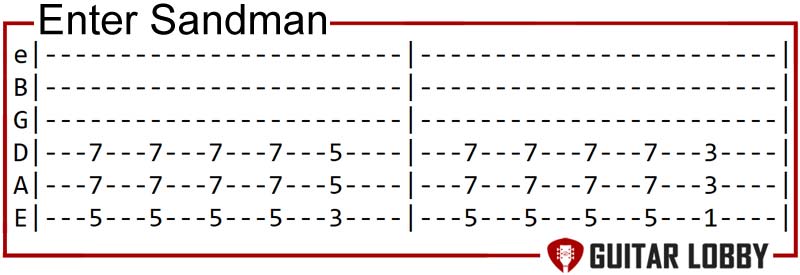
Tabs: See Enter Sandman by Metallica Tabs Here
“Enter Sandman” is celebrated for its opening sequence crafted by Kirk Hammett, which has become synonymous with the band and the thrash metal genre. Notably, “Enter Sandman” was pivotal in popularizing thrash metal in the early 1990s. Its lyrical exploration of nightmares and childhood fears adds depth, while Kirk Hammett’s guitar solo showcases his virtuosity, paving the way for Grammy nominations.
Tips to play it:
Master palm muting a crucial technique for achieving the song’s signature chugging sound. Use alternate picking (down-up-down-up) for the rapid picking sections, especially in the main riff. Maintain your picking hand’s accuracy, especially during faster sections. Lastly, focus on power chords (5th chords), as they form the basis of riffs and chords in the song.
32. Jump by Van Halen
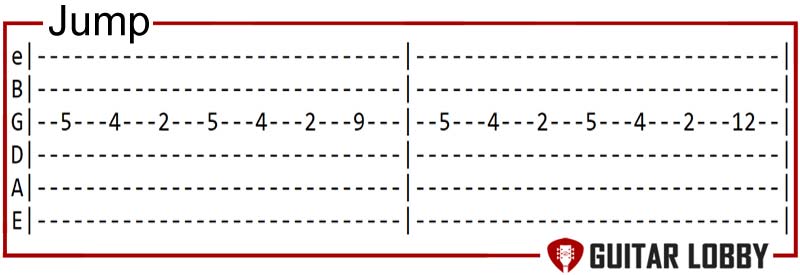
Tabs: See Jump by Van Halen Tabs Here
“Jump” is renowned for its synthesizer-driven melody and kicks off with an unforgettable guitar riff by Van Halen. The track masterfully fuses rock, pop, and synth elements. The song’s live performances, featuring dynamic guitar work by Van Halen and David Lee Roth’s powerful vocals, add to its energetic impact. Notably, the song features a unique keytar solo, a Grammy win, and an iconic music video.
Tips to play it:
Focus on the main riff, played on the original keyboard, but can be adapted to guitar. It consists of power chords and single-note runs. Along with it, use a clean or slightly distorted guitar tone to match the song’s sound. Remember that Eddie Van Halen’s original tone is bright and punchy.
33. Johnny B Goode by Chuck Berry
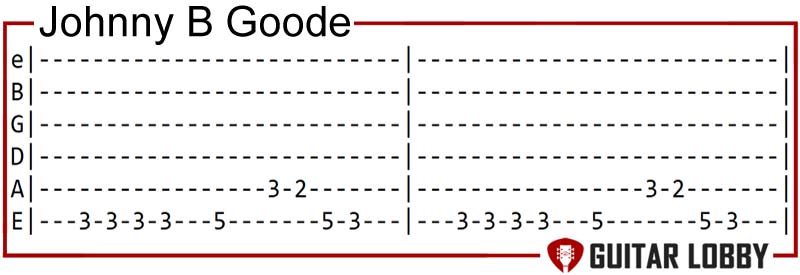
Tabs: See Johnny B Goode Tabs Here
“Johnny B. Goode” opens with a legendary guitar riff and a pioneering rock ‘n’ roll track, setting the standard for the genre with its infectious melody and Chuck Berry’s distinctive guitar style. The lyrics tell the tale of a young, aspiring guitarist named Johnny, inspiring generations of musicians and embodying the spirit of rock ‘n’ roll. The song features an iconic guitar solo, and Berry’s live performances, complete with his signature “duck walk,” were electrifying.
Tips to play it:
Chuck Berry’s guitar style is known for its rhythmic, staccato approach. Practice muting the strings with your palm between each strum to achieve that distinctive sound. Understand the 12-bar blues chord progression used in the song (E-A-B) and practice proper transitions.
34. Eye Of The Tiger by Survivor
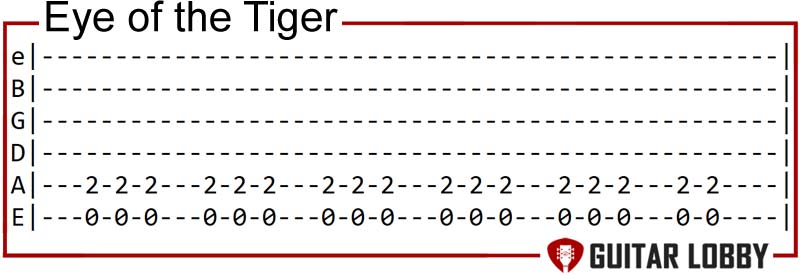
Tabs: See Eye Of The Tiger by Survivor Tabs Here
“Eye of the Tiger” goes beyond its musical prowess and is a motivational anthem. It was originally written for “Rocky III,” embodying determination and victory. The song’s massive commercial success, topping the Billboard Hot 100 and garnering a Grammy nomination, is a testament to its impact. The climactic instrumental section spotlights Sullivan’s guitar mastery, defining Survivor’s distinctive melodic rock sound.
Tips to play it:
Focus on mastering the opening riff by Sullivan to capture the song’s energy. Utilize alternate picking (down-up-down-up) for the riff to maintain the song’s driving rhythm. Familiarize yourself with the power chords (E5, B5, C5) used in the music. These chords form the backbone of the riff. Practice the bridge section, which features a different riff.
35. Spirit Of Radio by Rush
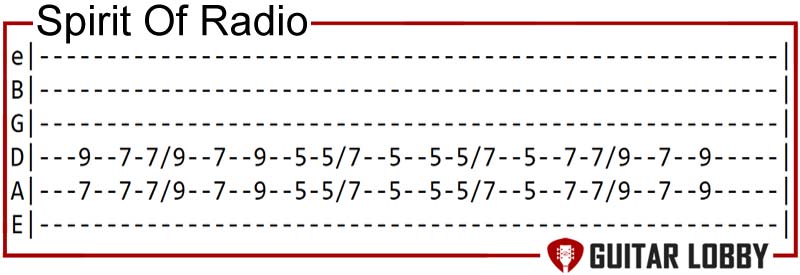
Tabs: See Spirit Of Radio by Rush Tabs Here
“Spirit of Radio” stands out for its fusion of rock, reggae, and jazz elements. It epitomizes Rush’s mastery of progressive rock, seamlessly blending intricate guitar work, complex time signatures, and meaningful lyrics, paying tribute to the radio’s impact on culture and music. Opening with a radio broadcast snippet, the track delves into the subject matter, adding depth to the song’s narrative.
Tips to play it:
Experiment with both fingerstyle and pick playing to see which approach works best for you. Be aware of the song’s changing time signatures and complex rhythms, especially during instrumental sections. Use a metronome to maintain precise timing. Focus on the distinctive main riff by Alex Lifeson as it’s the foundation of the song’s guitar work.
36. Message In The Bottle by The Police
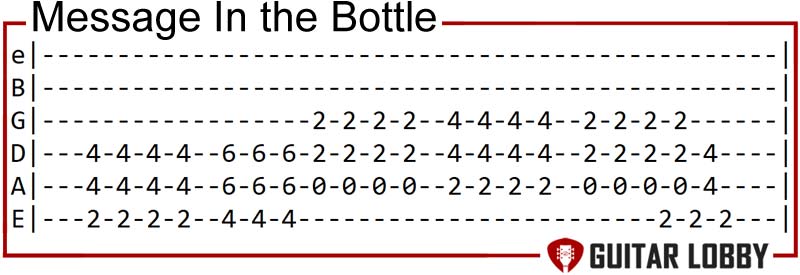
Tabs: See Message In The Bottle by The Police Tabs Here
“Message in a Bottle” hooks listeners while underscoring the song’s catchy melody, making it memorable and sing-along-friendly. The music starts with an infectious and instantly recognizable guitar riff skillfully played by Andy Summers. The track is a standout example of The Police’s distinctive fusion of rock, pop, and reggae, a hallmark of their signature sound. Sting’s evocative lyrics tell a universal tale of isolation and hope, adding depth to the song’s appeal.
Tips to play it:
The song kicks off with an infectious and instantly recognizable guitar riff skillfully played by Andy Summers. Emulate the reggae-infused rhythm by emphasizing the off-beats with your strumming hand, creating a distinctive syncopation. In addition, learn the arpeggio pattern for the bridge section.
37. Living On a Prayer by Bon Jovi
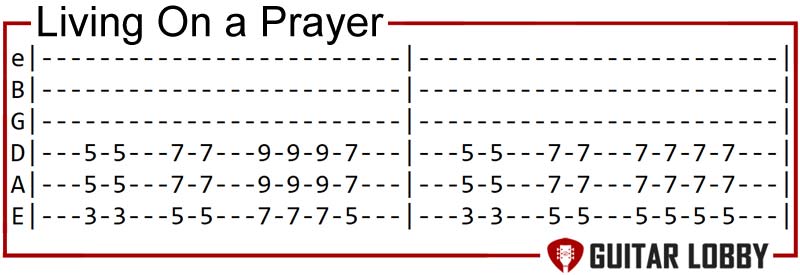
Tabs: See Living On a Prayer by Bon Jovi Tabs Here
“Living on a Prayer” has an iconic guitar riff, brilliantly played by Richie Sambora, setting the stage for an unforgettable musical journey. It perfectly encapsulates Bon Jovi’s signature sound, combining elements of rock, pop, and anthemic power ballads. The track’s storytelling lyrics, depicting the struggles and resilience of a working-class couple, strike a chord with listeners. Achieving massive commercial success and enduring popularity, it remains a staple of Bon Jovi’s electrifying live performances.
Tips to play it:
Richie Sambora’s guitar solo is a highlight. Practice with a backing track or metronome to ensure your timing remains consistent, especially during the fast-paced sections. Grasp the chord progressions in the song verses and chorus and combine them with a rhythmic strumming pattern.
38. Stairway To Heaven by Led Zeppelin
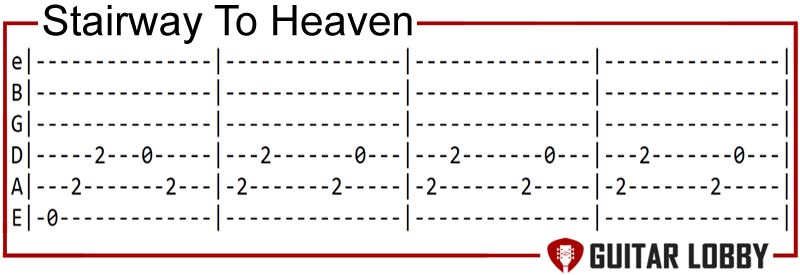
Tabs: See Stairway To Heaven by Led Zeppelin Tabs Here
“Stairway to Heaven” showcases Jimmy Page’s virtuosic and innovative guitar work, blending fingerpicking, arpeggios, and powerful solos. Notably, the song undergoes a captivating evolution, starting softly and building into a soaring rock anthem. Lyrically, it weaves a rich tapestry, adding depth and charisma. Its epic length and dynamic live performances by Led Zeppelin further underscore its iconic status, leaving an indelible mark on music and culture.
Tips to play it:
Begin by learning the fingerpicked intro played by Page. The intro and several sections of the song involve fingerpicking. Practice fingerstyle techniques to develop precision. Work on the arpeggios and solos, which are technically demanding. Break them into smaller sections and practice each part until you can play them smoothly.
39. Smells Like Teen Spirit by Nirvana
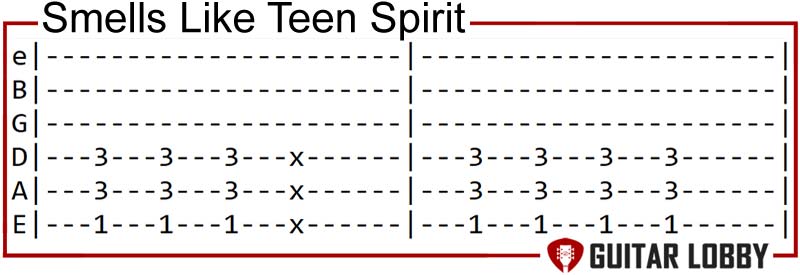
Tabs: See Smells Like Teen Spirit by Nirvana Tabs Here
“Smells Like Teen Spirit,” whose main guitar riff was delivered by Kurt Cobain, stands as one of the most iconic and influential in the history of rock music. Notably, this track serves as the grunge movement’s anthem, redefining rock music in the early ’90s. It was Nirvana’s breakthrough hit, propelling them to worldwide fame. The song’s lyrics, shrouded in ambiguity, allowed listeners to connect personally with its message.
Tips to play it:
Aggressive downstrokes with palm muting characterize Kurt Cobain’s guitar style in this song. Focus on your strumming technique to capture the energy. The song alternates between a quiet verse and a loud chorus. Switch between these sections smoothly. Also, use distortion or overdrive effects for the grudge sound.
40. La Bamba by Ritchie Valens
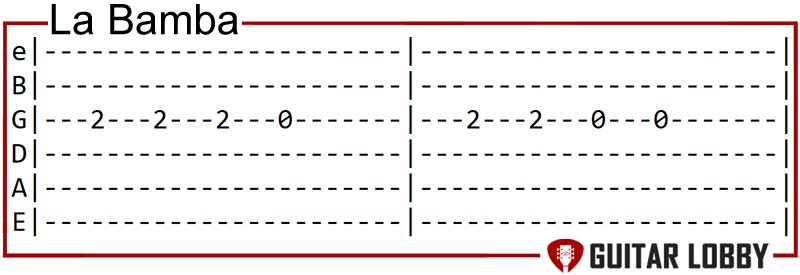
Tabs: See La Bamba by Ritchie Valens Tabs Here
“La Bamba” characterizes Valens’ fast-paced fingerpicking intro. It stands out as a fusion of rock and roll with traditional Mexican folk music, exemplified by including the iconic “¡Furiosa!” shout. Valens’ rendition entirely in Spanish broke language barriers, contributing to its historical significance in American music. Tragically, Ritchie Valens’ life was cut short in a plane crash shortly after releasing “La Bamba,” further adding to the song’s historical significance.
Tips to play it:
Begin by mastering the song’s iconic fingerpicked intro. Practice it slowly, paying attention to finger placement and timing. Palm muting can create a percussive effect in some parts of the song. Utilize a rhythmic strumming pattern that matches the song’s upbeat tempo. A simple down-up-down-up pattern works well.
41. All Right Now by Free
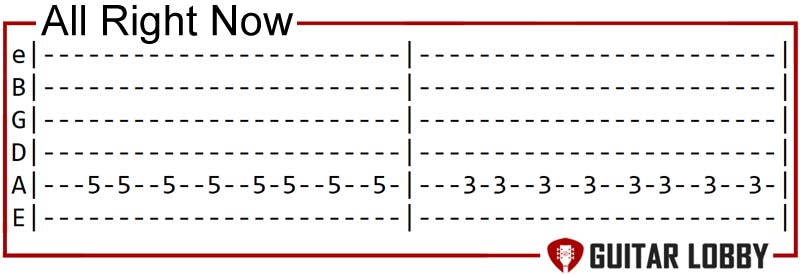
Tabs: See All Right Now by Free Tabs Here
“All Right Now” is a blend of bluesy guitar work and rock energy that epitomizes the blues-rock sound of the late ’60s and early ’70s. It was a pivotal hit that catapulted Free to international fame. Live performances of the song showcased the band’s musical prowess, often featuring extended guitar solos and jamming sessions. It remains a classic rock radio staple, frequently covered in popular culture.
Tips to play it:
Begin by mastering the song’s iconic guitar riff. It’s a catchy and repetitive sequence that opens the track. The riff’s timing is crucial. Focus on the rhythm and keep your strumming or picking hand in sync. Incorporate palm muting to add a percussive and bluesy touch, especially during the verses.
42. Wonderful Tonight by Eric Clapton
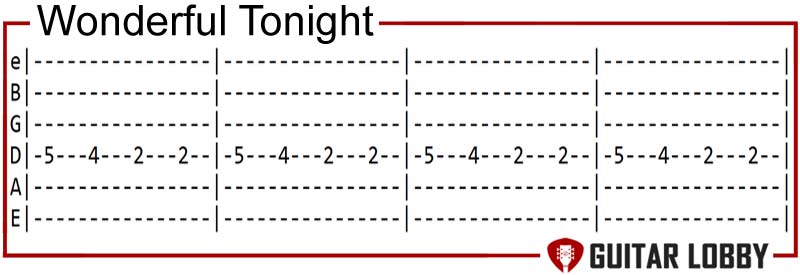
Tabs: See Wonderful Tonight by Eric Clapton Tabs Here
“Wonderful Tonight” features a breathtaking guitar solo by Clapton, showcasing his ability to convey deep emotions through his playing. As a timeless ballad, it has resonated with audiences for decades, with its heartfelt lyrics and soulful guitar work creating a memorable listening experience. Clapton’s decision to write it for his then-girlfriend, Pattie Boyd, adds a personal and touching dimension to the song. “Wonderful Tonight” enjoys cross-genre appeal and is often chosen for weddings and special occasions.
Tips to play it:
The song is primarily fingerpicked. Explore different chord inversions and voicings to add depth to your playing. Timing and dynamics are crucial in this song. Use subtle changes in volume and timing to emphasize specific phrases and create emotional impact. Wonderful Tonight by Eric Clapton easily has one of the greatest guitar riffs ever.
43. Oh Well by Fleetwood Mac
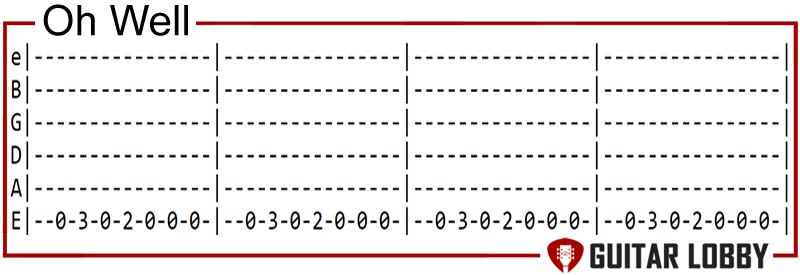
Tabs: See Oh Well by Fleetwood Mac Tabs Here
“Oh Well” is celebrated for its potent guitar riff by Peter Green. It embodies the mastery of blues-rock that Fleetwood Mac was known for, seamlessly fusing blues elements with rock to create a captivating, high-energy sound. Notably, “Oh Well” has a unique two-part structure, transitioning from the driving rock riff to a haunting acoustic passage, adding depth and intrigue. Its enigmatic lyrics contribute to its mystique.
Tips to play it:
“Oh Well” has a distinct bluesy feel. Focus on playing with the same bluesy emotion and expressiveness Peter Green brought to the song. Use alternate picking to maintain precision during faster passages. Experiment with sustain and bending techniques to replicate the notes’ tonal qualities and vibrato in the original song.
44. Paranoid by Black Sabbath
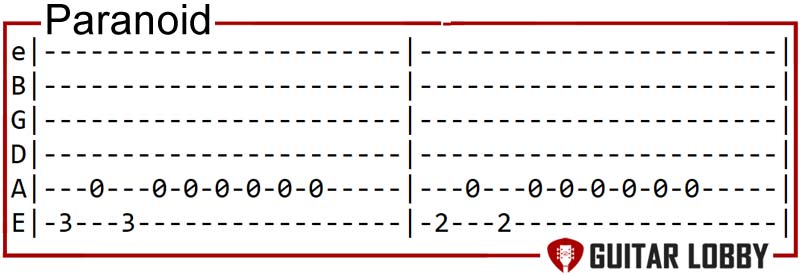
Tabs: See Paranoid by Black Sabbath Tabs Here
“Paranoid” goes beyond its musical excellence and has pioneered the heavy metal genre. Despite its concise two-minute runtime, the song packs a powerful punch, featuring raw and relatable lyrics exploring anxiety and paranoia themes. It has been covered by numerous artists and referenced in various forms of media, attesting to its enduring cultural impact.
Tips to play it:
Learn the power chord shapes for E5, F5, and G5 and practice transitioning between them smoothly. Use palm muting to create the heavy, chugging sound of the song’s riff. Rest the edge of your palm lightly on the strings near the bridge while strumming. For the intro and solo, practice bending the strings and then releasing them to create the desired effect.
45. Sweet Home Alabama by Lynyrd Skynyrd
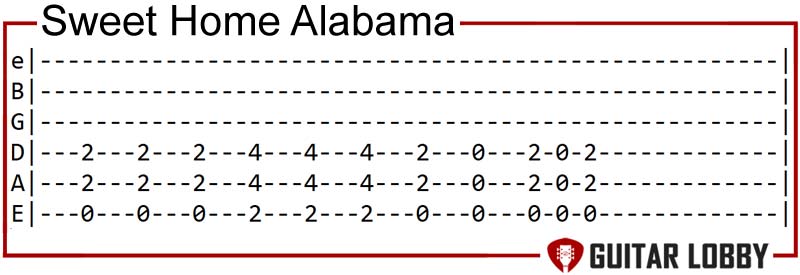
Tabs: See Sweet Home Alabama by Lynyrd Skynyrd Tabs Here
“Sweet Home Alabama” is renowned for its catchy melody and distinctive Southern rock vibe. It encapsulates the essence of Southern rock, blending rock and blues elements with a unique Southern flavor. Moreover, the song responds musically to Neil Young’s “Southern Man,” adding depth to its narrative.
Tips to play it:
The riff includes triplets, where you play three notes quickly in succession. Focus on getting these triplets right for authenticity. Also, in the riff, there’s a slide up from the 2nd to the 4th fret on the D string. Master this slide for accuracy. The riff occurs during the intro and between verses. Practice this riff separately until you can play it smoothly. The strumming includes a simple down-up-down-up pattern.
46. The One I Love by Rem
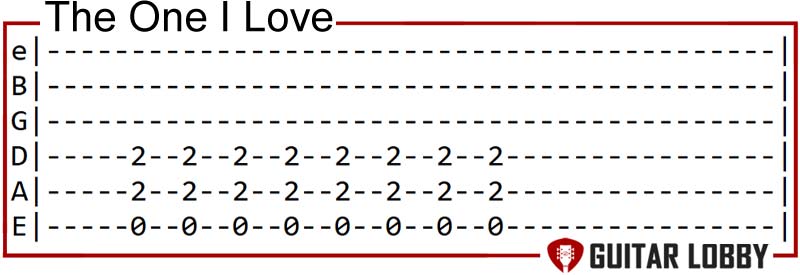
Tabs: See The One I Love by Rem Tabs Here
“The One I Love” boasts a straightforward yet highly effective guitar riff that immediately grabs the listener’s attention. While the lyrics may appear romantic initially, they carry a darker undertone, creating an intriguing contrast with the upbeat riff. This ambiguity allows for various interpretations and adds depth to the song.
Tips to play it:
The main riff follows this pattern: G – D – G – B – G – D – G – B. It is essentially an arpeggiated G chord. Practice picking the G chord one note at a time, starting from the low E string and moving up. Also, Peter Buck’s signature jangle pop sound includes a continuous, up-and-down strumming pattern. Keep your strumming hand moving rhythmically.
47. Sunshine Of Your Love by Cream
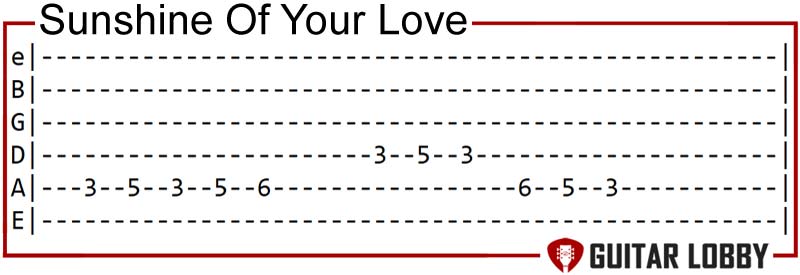
Tabs: See Sunshine Of Your Love by Cream Tabs Here
“Sunshine of Your Love” is a masterful fusion of blues and rock, setting a benchmark for the genre. Cream’s live performances often featured extended improvisational guitar solos, showcasing Clapton’s virtuosity. Collaboratively, with Jack Bruce on bass and Ginger Baker on drums, the song’s cultural impact and influence on rock music undeniably solidifies its place as a rock classic.
Tips to play it:
Learn the pentatonic scale, as this riff is based on it. Play the scale up and down to get a feel. Eric Clapton uses a slide technique for some parts of the riff. Consider a glass or metal slide to mimic this effect. Use moderate amounts of distortion, bent notes, and vibrato to capture the song’s signature tone.
48. Breaking The Law by Judas Priest
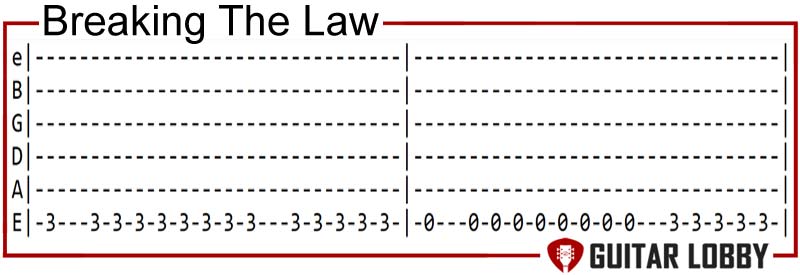
Tabs: See Breaking The Law by Judas Priest Tabs Here
“Breaking the Law” is a hallmark of heavy metal music and is celebrated for its energetic and driving quality. Its simplicity and catchiness make it a fan favorite for sing-along moments during live performances, forging a strong bond between the band and its audience. Beyond the riff, the song’s rebellious lyrics add depth, while a standout guitar solo by Glenn Tipton showcases technical prowess.
Tips to play:
The main riff consists of power chords. Start by practicing power chords on the 6th (Eb) and 5th (Ab) strings, then move to other chords in the song. Use alternate picking (down-up-down-up) for the power chords to maintain a steady rhythm. Play each power chord with a staccato feel for the choppy sound.
49. Seven Nation Army by The White Stripes
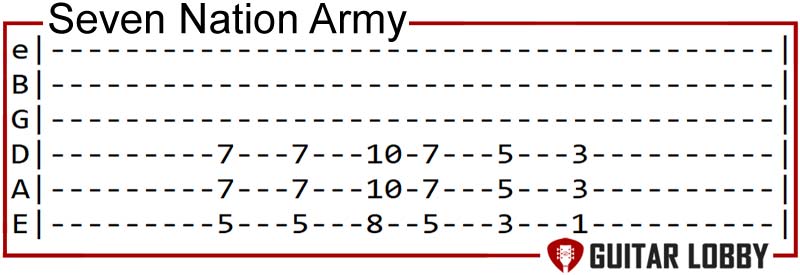
Tabs: See Seven Nation Army by The White Stripes Tabs Here
“Seven Nation Army” is popular for Jack White’s minimalist riff, played on a semi-acoustic guitar with a broken pickup, and stands as one of rock music’s most recognizable motifs. Its repetitive, low-pitched pattern exudes a hypnotic power, transforming it into an anthem at sporting events and concerts worldwide.
Tips to play:
Place your index finger on the 7th fret of the A string (5th string). Use only your index finger to press down on the 7th fret. Strum the A string with a downstroke while keeping your index finger firmly on the 7th fret. Rest the palm of your hand lightly on the strings below the one you’re playing (D, G, B, e) to mute them and prevent unwanted noise.
50. Owner Of a Lonely Heart by Yes
Tabs: See She Sells Sanctuary by The Cult Tabs Here
“She Sells Sanctuary” features a captivating guitar riff by Billy Duffy. The riff combines open chords and sliding power chords. The song uniquely blends rock, post-punk, and alternative rock. Its echoing guitar tone adds an atmospheric and ethereal element to the music. This song’s broad appeal sets this song apart, drawing in both rock fans and those who appreciate alternative and post-punk genres.
Tips to play:
Place your index finger on the 7th fret of the A string (5th string). Use your palm to mute the strings between strums, creating a staccato effect. Start by playing the riff at a slower tempo and gradually increase your speed as you become more comfortable. Transition smoothly between the A and G chords.
52. Hells Bells by AC/DC
Tabs: See Hells Bells by AC/DC Tabs Here
“Hells Bells” by AC/DC is etched into the annals of rock history. Angus Young’s straightforward yet powerful riff is synonymous with AC/DC’s unmistakable sound. The impactful introduction, featuring haunting guitar work and tolling bells, sets the stage for the song’s dark and foreboding lyrics. Angus Young’s dynamic guitar skills are showcased in the transition from the intro to the explosive power chords in the chorus.
Tips to play:
The song opens with the atmospheric bell tolling and a clean guitar intro. You can mimic the bell tolling by playing harmonics on the 4th, 5th, and 7th frets of the G, B, and high E strings. Emphasize the accents in the riff and play with intensity to give the signature punch.
53. One Vision by Queen
Tabs: See One Vision by Queen Tabs Here
“One Vision” boasts a dynamic and unforgettable guitar riff courtesy of Brian May. Notably, it’s the product of a collaborative jam session with May, Freddie Mercury, Roger Taylor, and John Deacon. “One Vision” gained additional prominence by being featured in the film “Iron Eagle” in 1986, solidifying its reputation as a high-energy rock anthem.
Tips to play:
Use palm muting to achieve that staccato effect. The primary riff is played on the A string (5th string) and involves sliding between notes. Start with the 5th fret, slide up to the 7th fret, then slide down to the 5th fret, and finally hit the 3rd fret. You can use distortion and treble settings on the amplifier for Brian May’s signature sound.
54. Carry On Wayward Son by Kansas
Tabs: See Carry On Wayward Son by Kansas Tabs Here
“Carry On Wayward Son” seamlessly blends elements of progressive rock with a catchy, radio-friendly sound, making it both musically complex and accessible. Lyrically, it delves into themes of self-discovery, adding depth to its composition. The song’s strategic placement as the final track on the album “Leftoverture” adds a sense of grandeur, and its enduring popularity in classic rock radio and media further solidifies its status as a timeless classic.
Tips to play:
The opening riff involves several hammer-ons and pull-offs. Break it into smaller sections and practice slowly to build speed. The quieter sections feature fingerpicking patterns. The music combines strums and palm-muted notes for the driving rhythm. Also, focus on the instrumental section, which includes fast-paced arpeggios and leads.
55. Pretty Vacant by Sex Pistols
Tabs: See Pretty Vacant by Sex Pistols Tabs Here
“Pretty Vacant” holds a special place as a punk anthem, embodying the do-it-yourself ethos and rebelliousness at the core of punk music. The song was released during the punk explosion of the 1970s and remains a symbol of that era. With anti-establishment lyrics delivered with Johnny Rotten’s distinctive snarl, “Pretty Vacant” captures the essence of punk counterculture.
Tips to play:
Practice forming power chords on the 6th and 5th strings, typically starting on the 5th fret. Punk songs often have a fast and aggressive strumming pattern. Use downstrokes for a punchy sound, and maintain a steady rhythm throughout the song. Use a distortion or overdrive pedal for the gritty tone characteristic of punk rock. Use palm-muting for a chugging sound.
56. Alive by Pearl Jam
Tabs: See Alive by Pearl Jam Tabs Here
“Alive” epitomizes the raw, emotional sound of the grunge era in the early 1990s, making it a quintessential grunge anthem. Eddie Vedder’s distinctive and passionate vocals complement the riff beautifully, enhancing the song’s impact. Moreover, the deeply personal and introspective lyrics add a layer of meaning to the music. “Alive” holds a special place in Pearl Jam’s live performances, often featuring impressive guitar solos by McCready.
Tips to play:
The bridge features a melodic guitar solo by Mike McCready. Study his phrasing and technique. Focus on learning the opening riff, which involves a mix of power chords and single-note melodies. Practice the riff slowly and gradually increase your speed. Use a combination of downstrokes and upstrokes to match the rhythm.
57. No Surprises by Radiohead
Tabs: See No Surprises by Radiohead Tabs Here
“No Surprises” is a critically acclaimed song performed in an alternative tuning, DADGAD, contributing to its distinctive and resonant sound. While Radiohead often explores electronic experimentation, “No Surprises” is an acoustic-driven gem, showcasing the band’s versatility. The song’s iconic music video, featuring Thom Yorke submerged in a water-filled helmet, complements its suffocating message.
Tips to play:
Adopt a soft and delicate strumming pattern that complements the song’s gentle mood. Use fingerpicking or light strumming to avoid overpowering the delicate chords. Also, focus on arpeggiating the chords. Pluck the individual strings of each chord in a flowing and melodic manner to capture the song’s atmospheric quality. Place a capo on the 2nd fret to match the pitch of the original recording.
58. Master Of Puppets by Metallica
Tabs: See Master Of Puppets by Metallica Tabs Here
“Master of Puppets” showcases Metallica’s technical prowess, featuring intricate palm-muted chugging and lightning-fast alternate picking. As a quintessential thrash metal anthem, it embodies the genre’s high-energy sound. Beyond the music, the song delves into dark and introspective themes, complementing its ominous atmosphere. “Master of Puppets” has left an indelible mark on the cultural landscape.
Tips to play:
Begin by playing the riffs slowly and accurately. The opening riff relies heavily on palm muting. Practice it to achieve the tight, chugging sound. Additionally, many parts of the song require fast alternate picking. Work on picking techniques for clarity and speed. A metronome can help you keep time, especially during the rapid sections. Gradually increase the tempo as you become more comfortable.
59. Hocus Pocus by Focus
Tabs: See Hocus Pocus by Focus Tabs Here
“Hocus Pocus” is a fusion of rock, jazz, and classical elements that places it firmly within the progressive rock genre, where its complexity and genre-blending set it apart. Thijs van Leer’s versatility, from yodeling and scat singing to organ and flute playing, adds a dynamic dimension to the song. Furthermore, its unconventional structure, live performance energy, enduring popularity, and cultural impact make it an iconic classic in music.
Tips to play:
The signature yodeling guitar riff is the centerpiece of the song. It involves quick slides and hammer-ons. Notably, the yodeling riff requires speed and precision. Start slow and gradually build up your momentum. Also, the song is played with a capo on the second fret, so place it correctly.
60. Fly Away by Lenny Kravitz
Tabs: See Fly Away by Lenny Kravitz Tabs Here
“Fly Away” seamlessly blends rock, funk, and pop genres in this track, showcasing his talent for crafting a unique and genre-defying sound. “Fly Away” possesses a timeless quality that continues to resonate across generations, and its radio-friendly, guitar-driven sound contributed to its commercial success. Additionally, Lenny Kravitz’s iconic image as a rock star is closely associated with his guitar prowess, further emphasizing the significance of the song’s riff.
Tips to play:
Pay attention to the rhythm of the strumming pattern. It’s a driving, upbeat rhythm that adds to the song’s energy. To replicate the song’s rock sound, use distortion or overdrive effects on your guitar. Also, note that the chorus involves strumming the power chords openly for a fuller sound.
61. Cigarettes and Alcohol
Tabs: See Cigarettes and Alcohol by Oasis Tabs Here
“Cigarettes and Alcohol” captures the essence of classic rock and roll, drawing inspiration from legends like The Rolling Stones and The Who. Built on powerful chords, it exudes raw energy, perfectly complementing the song’s lyrical themes of youth and rebellion. Oasis’ electrifying live performances often feature the song as a highlight, underlining the significance of its riff in their repertoire.
Tips to play:
The song’s main riff revolves around power chords. Learn the basic power chords used in the music: E5, A5, and D5. The intro has a slide from the 3rd fret to the 5th fret on the low E string. Work on this slide to make it smooth and seamless. Use palm muting to create a percussive sound.
62. House Of The Rising Sun by The Animals
Tabs: See House Of The Rising Sun by The Animals Tabs Here
“House of the Rising Sun” features one of rock history’s most iconic guitar riffs—a descending arpeggio on the electric guitar that immediately grabs the listener’s attention. The Animals’ rendition of this traditional folk song, featuring Eric Burdon’s powerful vocals and Hilton Valentine’s distinctive guitar work, holds historical significance in the folk and rock revival of the 1960s.
Tips to play:
Place your index finger on the 1st fret, high E, and your other fingers on the 2nd fret, B string, 3rd fret on the G string, and 4th fret, D string. Use a pick to strike the 1st (high E) string and then strum downward through the 2nd, 3rd, and 4th strings with your fingers in a quick, fluid motion.
63. No One Knows by Queens Of The Stone Age
Tabs: See No One Knows by Queens Of The Stone Age Tabs Here
“No One Knows” begins with a striking and forceful guitar riff played by Josh Homme. The track incorporates layered guitar tracks, adding depth to the riff and enhancing the song’s overall intensity. It exemplifies the band’s signature sound, earning critical acclaim and commercial success while featuring Dave Grohl on drums for added musical prowess. The riff often gets extended in live performances, showcasing the band’s musicianship.
Tips to play:
Break the riff into smaller sections and practice each part separately before playing the entire riff. Employ alternate picking (down-up-down-up) to execute the rapid succession of notes in the riff smoothly. Practice with a metronome to develop a steady sense of timing and rhythm, as the riff has a distinctive groove.
64. Gyöngyhajú Lány by OMEGA
Tabs: See Gyöngyhajú Lány by OMEGA Tabs Here
“Gyöngyhajú Lány” features a unique fusion of rock, progressive rock, and folk elements. Released in 1969, the song has a timeless appeal, enduring as a classic in Hungarian rock music. Its guitar riff has a haunting, emotional quality that resonates deeply with listeners. OMEGA’s experimental approach to rock is evident in this song, pushing musical boundaries.
Tips to play:
Start at a slow tempo and gradually increase your speed as you become more comfortable with the song. The song allows for some improvisation and embellishments. Feel free to add your unique touches to make it your own. Also, play softly during verses and build up the intensity during the chorus. Lastly, practice transitioning smoothly between the chords in the progression.
65. I Can’t Explain by The Who
Tabs: See I Can’t Explain by The Who Tabs Here
“I Can’t Explain” influences the mod and rock movements of the 1960s and is undeniable, and its raw energy helped shape British rock. Pete Townshend’s pioneering use of power chords in the song became a hallmark of rock guitar playing. The song’s enigmatic lyrics add depth, setting it apart from typical rock tunes. It remains a favorite live performance staple for The Who, showcasing its timeless appeal and enduring popularity.
Tips to play:
Practice transitioning between the A, D, and E chords for the verses and chorus. Pay attention to the bridge section, where the chords change rapidly. Practice this part until you can switch chords quickly and cleanly. Work on your strumming pattern, as capturing the energy is essential.
66. Seek And Destroy by Metallica
Tabs: See Seek And Destroy by Metallica Tabs Here
“Seek and Destroy” has become synonymous with Metallica’s unique sound and is instantly recognizable. The song played a pivotal role in the emergence of thrash metal, setting the stage for the genre’s dominance in the 1980s. “Seek and Destroy” is a studio classic and a live performance anthem for Metallica, known for its intense energy and crowd engagement. The song’s lyrics, which convey a sense of seeking and destruction, complement the aggressive guitar riff.
Tips to play:
Metallica is known for their heavy use of downstrokes. Practice playing the main riff using mostly downstrokes for that signature chugging sound. The song also incorporates alternate picking, especially in the faster sections. Focus on switching between barre chords smoothly during the solo.
67. Born To Run by Bruce Springsteen
Tabs: See Born To Run by Bruce Springsteen Tabs Here
“Born to Run” is characterized by its energetic and driving rhythm, which propels the song forward, creating a sense of urgency and excitement that complements its lyrical theme. One of the unique aspects of the music is its storytelling lyrics, which paint a vivid picture of a young couple yearning for freedom and adventure. As a timeless classic and one of rock’s greatest anthems, “Born to Run” has left an indelible mark on music history.
Tips to play:
The song primarily uses basic chords like G, C, D, and Em. Make a note of the driving and rhythmic downstroke strumming pattern that matches the energy. It also involves sliding and bending notes, so work on finger strength and accuracy.
68. Cemetery Gates by Pantera
Tabs: See Cemetery Gates by Pantera Tabs Here
“Cemetery Gates” highlights Dimebag’s technical prowess in this track, with intricate arpeggios, harmonics, and blistering solos that showcase his virtuosity. This song seamlessly fuses heavy metal and hard rock elements, contributing to the groove metal subgenre’s evolution. The song is known for its thought-provoking lyrics that touch on themes of loss, longing, and introspection.
Tips to play:
Practice the arpeggio sections in the song, such as the harmonics in the intro and the melodic arpeggios in the verses. Start by mastering the hauntingly melodic opening riff. Practice it slowly, focusing on accuracy and timing. The song also features a beautiful and challenging guitar solo. So, break it down into smaller sections and practice it gradually to build speed and accuracy.
69. Fools Gold by The Stone Roses
Tabs: See Fools Gold by The Stone Roses Tabs Here
“Fools Gold” seamlessly blends rock, funk, and dance elements, showcasing its genre-defying nature. The song’s unconventional time signature, alternating between 6/4 and 4/4, adds an intriguing rhythmic complexity to the riff. Squire uses open-G tuning (D G D G B D) to enhance the distinctive sound. With its dreamy, psychedelic influence and extended instrumental jam, “Fools Gold” remains a timeless classic in the alternative and indie rock scenes.
Tips to play:
The main riff is played on the 9th fret and is relatively straightforward once you get the hang of the open-G tuning. Incorporate slides to capture the smooth and fluid feel, especially when moving between chords or notes. Emphasize the funk elements by playing with a rhythmic, staccato feel.
70. Billie Jean by Michael Jackson
Tabs: See Billie Jean by Michael Jackson Tabs Here
“Billie Jean” seamlessly complements the song’s funky groove, with palm muting and staccato notes adding a rhythmic and percussive quality. The song is famous for its groundbreaking video featuring the iconic light-up sidewalk. It fuses pop, funk, and R&B elements.
Tips to play:
Use a clean or slightly distorted tone on your amplifier. The riff doesn’t require heavy distortion. Start with your index finger on the 7th fret of the A string. Then, use your middle finger to press down on the 9th fret of the D string. Play this A-D string combination three times. Move your hand up to the 5th fret of the A string and the 7th fret of the D string and play this combination twice.
71. Apache by The Shadows
Tabs: See Apache by The Shadows Tabs Here
“Apache” is an instrumental rock classic, propelled by Hank Marvin’s innovative guitar work, and is known for its pioneering use of the electric guitar. “Apache” profoundly influenced the development of rock and surf music, inspiring countless guitarists and bands. Its commercial success and chart-topping status in the UK in 1960 solidified The Shadows’ position as instrumental rock pioneers.
Tips to play:
Use a clean guitar tone with some reverb to capture the authentic sound. This will help achieve the twangy and atmospheric quality of the original recording. Using palm muting on specific notes for the original staccato feels. Tremolo picking is a crucial aspect of the song. Practice alternate picking and use varying degrees of tremolo for the right effect.
72. Hey Joe by Jimi Hendrix
Tabs: See Hey Joe by Jimi Hendrix Tabs Here
“Hey Joe” highlights Hendrix’s masterful use of the Fender Stratocaster and his unique bending of notes and creative application of wah-wah effects. While rooted in the blues, his interpretation adds a psychedelic and rock edge. Additionally, the song’s captivating lyrics tell a story of contemplation and consequences, and countless artists have covered it, though Hendrix’s version remains definitive.
Tips to play:
Hendrix often used a loose and rhythmic strumming pattern. Experiment with downstrokes, upstrokes, and muting to capture his style. If you have a wah-wah pedal, experiment with it to mimic the signature sound. Use it during the intro and solo sections for added authenticity. Hendrix’s bends are a crucial element of his playing. Work on them for solo parts.
73. Run To You by Bryan Adams
Tabs: See Run To You by Bryan Adams Tabs Here
“Run To You” delves into a complex emotional theme, exploring the struggle between commitment and temptation in a relationship. This depth adds an exciting layer to the song, making it relatable to a broad audience. Its fusion of rock and pop elements sets the song apart, creating a radio-friendly and rock-infused sound, showcasing Bryan Adams’ talent for crafting songs.
Tips to play:
Use a simple downstroke strumming pattern for the verses, emphasizing the chords at the right moments. Also, switch to the chords A, D, and E in the chorus, and you can use a more energetic strumming pattern to match the song’s intensity. The music includes an intro and two verses using A, D, E, G, and Bm chords.
74. A Whiter Shade Of Pale by Procol Harum
Tabs: See A Whiter Shade Of Pale by Procol Harum Tabs Here
“A Whiter Shade Of Pale” complements the haunting organ, creating a unique, dreamlike atmosphere. What adds to the song’s allure is the mysterious and enigmatic nature of its lyrics and music, never fully explained by the songwriter, Keith Reid. As a timeless classic, it has maintained its influence across genres, a testament to the enduring power of its combination of guitar and organ.
Tips to play:
Use a slow, gentle strumming pattern matching the song’s dreamlike quality. A simple down-up-down-up pattern can work well. For the iconic organ melody, you can fingerpick to pluck individual notes within the chords. Focus on the high strings to create a haunting sound. Use reverb and chorus effects to capture the song’s ethereal ambiance.
75. Stay With Me by Faces
Tabs: See Stay With Me by Faces Tabs Here
“Stay With Me” is A classic rock song exuding energy and swagger, with the guitar riff playing a pivotal role in driving its infectious groove. Rooted in bluesy rock, the riff adds depth and authenticity to the track, showcasing the enduring appeal of blues-based riffs in rock music. Notably, the riff was a collaborative effort between Ron Wood and Rod Stewart, highlighting the chemistry between musicians in Faces.
Tips to play:
The main riff is played on the lower strings. Start with a downstroke on the 3rd fret of the A string. Make a quick upstroke on the 5th fret of the A string. Incorporate open chords like G, C, and D for a fuller sound during the chord progressions.
76. Sweet Dreams by Marilyn Manson
Tabs: See Sweet Dreams by Marilyn Manson Tabs Here
Marilyn Manson’s “Sweet Dreams (Are Made of This)” provides a unique and edgy twist to the original Eurythmics track. Manson’s cover of this synth-pop hit is iconic, showcasing the power of a well-executed riff in transforming a song’s genre. Notably, the track and its controversial music video pushed boundaries.
Tips to play:
The iconic guitar riff starts with a palm-muted open sixth (low D) string followed by the 3rd fret on the exact string, played in quick succession. The song also features power chords in the chorus sections, played on the 5th and 7th frets of the A string and the 3rd and 5th frets of the low D string. Also, use a heavy distortion pedal for the gritty tone.
77. Atomic by Blondie
Tabs: See Atomic by Blondie Tabs Here
“Atomic” is a fusion of pop, new wave, and punk elements, a signature characteristic of Blondie’s sound. The guitar riff and Debbie Harry’s unmistakable vocals contribute significantly to the song’s enduring popularity. Initially conceived as an instrumental by Blondie’s lead guitarist, Jimmy Destri, the addition of lyrics by Debbie Harry transformed it into the iconic hit we know today.
Tips to play:
Start with your index finger on the 2nd fret of the A (5th) string and your ring finger on the 4th fret of the D (4th) string. Strum only the A, D, and G strings (5th, 4th, and 3rd) while muting the rest with your palm. Also, note that the song’s riff follows a steady 8th-note rhythm pattern.
78. Ace Of Spades by Motorhead
Tabs: See Ace Of Spades by Motorhead Tabs Here
“Ace of Spades” sets a fast-paced, aggressive tone that encapsulates the raw power of rock music. The song’s influence on the genre is immense, serving as a benchmark for countless bands. Lyrically, it explores themes of gambling and the thrill of living on the edge, with Lemmy Kilmister’s distinctive vocals adding to its allure. The song’s unique aspects include Lemmy’s dual role as bassist and vocalist, its breakneck tempo, and its widespread presence in pop culture.
Tips to play:
The main riff is played on the E and A strings primarily. To achieve the signature chugging sound, use palm muting. Use alternate picking (down-up-down-up) for the fast-paced sections to maintain accuracy and speed. Use a metronome for the blistering tempo.
79. Life In The Fast Lane by Eagles
Tabs: See Life In The Fast Lane by Eagles Tabs Here
“Life in the Fast Lane” showcases Joe Walsh’s exceptional talent. What sets this song apart is its masterful fusion of rock, blues, and funk, appealing to a wide-ranging audience. Moreover, the dual lead guitar work by Joe Walsh and Don Felder elevates the song to another level, featuring intricate and melodic solos. The timeless lyrics vividly depict the glamorous ’70s rock scene.
Tips to play:
Divide the riff into sections and practice each part separately before attempting the whole riff. Pay close attention to bending notes, especially the G to A bend, a signature part of the riff. Incorporate vibrato in your bends to add emotion to the notes. Note that Joe used a whammy bar for the pitch bends.
80. Zombie by The Cranberries
Tabs: See Zombie by The Cranberries Tabs Here
“Zombie” highlights an arpeggio that carries a haunting quality, effectively complementing the song’s poignant lyrics and crafting a reflective and melancholy ambiance. As an emblem of ’90s alternative rock, “Zombie” underscores its era’s musical essence while addressing the Troubles in Northern Ireland, lending it cultural significance. That and Dolores O’Riordan’s distinctive and powerful vocals, though not tied to the guitar, further enhance the song’s impact and memorability.
Tips to play:
The main arpeggio revolves around chords G, D/F#, Em, and Cadd9, repeating throughout the song. You can strum the chords during the chorus to add intensity but return to the arpeggio for the verses. Use a fingerpicking pattern to pluck – thumb: T, index: I, middle: M, and ring: R.
81. Milk And Alcohol by Dr. Feelgood
Tabs: See Milk And Alcohol by Dr. Feelgood Tabs Here
“Milk and Alcohol” epitomizes the raw and gritty essence of blues-rock, a genre that Dr. Feelgood was renowned for. What makes the song even more remarkable is its danceable groove, which sets it apart in the rock genre. Additionally, the harmonica and guitar combination creates a dynamic interplay, adding depth to the sound. The lyrics, narrating a tale of indulgence, are delivered with charismatic vocals.
Tips to play:
Use power chords for most of the riff. Start with an A5 power chord, then move to a D5 power chord, and finally to a G5 power chord. Strum the power chords with a steady rhythm. The song’s verse uses similar power chords. It starts with A5, then D5, and finally E5.
82. Black Night by Deep Purple
Tabs: See Black Night by Deep Purple Tabs Here
“Black Night” was written and recorded in a remarkably short span – composed in a single afternoon and recorded that evening. The song’s genesis was serendipitous, with guitarist Ritchie Blackmore spontaneously crafting the iconic riff during a studio jam session. Blackmore’s distinctive guitar work, marked by staccato picking and a bluesy rock vibe, defines the track.
Tips to play:
Ritchie Blackmore’s solo in the song is iconic but challenging. It involves a mix of fast picking and bluesy bends. Practice it slowly and gradually build up speed. Also, The outro repeats the main riff. The verse and chorus chords are straightforward power chords – A5, G5, D5, E5. Also, remember that Deep Purple’s music often relies on a tight groove.
83. Spoonman by Soundgarden
Tabs: See Spoonman by Soundgarden Tabs Here
“Spoonman” plays a significant role in the history of grunge music, with Soundgarden being the genre’s pioneer in the 1990s. What sets “Spoonman” apart is the inclusion of unconventional elements, like Artis the Spoonman playing actual spoons for percussion, adding a unique layer to the song’s texture. Furthermore, the lyrics delve into themes of urban alienation and the quest for meaning in a fast-paced world.
Tips to play:
The main riff consists of power chords and single notes. Start by playing the power chords (D5, Bb5, G5, F5) in a palm-muted, rhythmic pattern. After playing the power chords, add the single-note melody that follows. Also, to capture the song’s heavy grunge sound, use distortion or overdrive effects on your guitar.
84. Cocaine by Eric Clapton
Tabs: See Cocaine by Eric Clapton Tabs Here
“Cocaine” features Eric Clapton’s masterful blend of blues and rock elements, evident in this instantly recognizable sequence of notes, setting the song’s tone. It showcases Clapton’s exceptional guitar skills, infusing emotion into his playing. The song’s live performances are a testament to his improvisational brilliance, making it a staple at his concerts.
Tips to play:
The opening riff is the heart of the song. Practice it slowly at first, focusing on accuracy and gradually increasing the speed. In addition, use a combination of palm muting and open strumming for the right rhythm. If you’re up for the challenge, try to learn Clapton’s guitar solo. Also, blues-rock is all about the groove and feeling the music. Try to capture the essence.
85. Should I Stay Or Should I Go by The Clash
Tabs: See Should I Stay Or Should I Go by The Clash Tabs Here
“Should I Stay Or Should I Go” has an intriguing history. Although originally released in 1982, it enjoyed a resurgence in popularity during the 2000s when it featured prominently in commercials and films, introducing it to new-gen listeners. It features bilingual lyrics, with lead singer Joe Strummer seamlessly switching between English and Spanish, giving it a unique multicultural flair that distinguishes it within the rock genre.
Tips to play:
The iconic riff starts with an open D power chord (5th fret on the A string), followed by a G (3rd fret on the low E string) and an A (5th fret on the low E string). Also, use downstrokes for a crisp sound. Listen to the song for the rhythm.
86. Nothing Else Matters by Metallica
Tabs: See Nothing Else Matters by Metallica Tabs Here
“Nothing Else Matters” demonstrates Metallica’s ability to meld heavy metal intensity with melodic complexity, showcasing their versatility. Notably, the lyrics delve into deeply personal and introspective territory, setting it apart within Metallica’s discography. Moreover, the song seamlessly blends acoustic and electric guitar elements, contributing to its unique sound.
Tips to play:
The song has soft and loud parts. Focus on the dynamics to convey the emotions effectively. Use your picking hand to control the volume and intensity. The signature intro of the song is fingerpicked. Practice with a metronome to improve your timing and rhythm. This will help stay in sync with the tempo changes. Metallica uses effects like reverb and delay. Experiment with these effects to replicate the atmosphere.
87. Killing In The Name Of by Rage Against The Machine
Tabs: See Killing In The Name Of by Rage Against The Machine Tabs Here
“Killing in the Name” matches its themes of protest and anger perfectly. Notably, the song gained renewed popularity in 2009 when a Facebook campaign propelled it to the Christmas number-one spot in the UK charts, showcasing its enduring relevance. The song’s lyrics address police brutality and racism, and Morello’s unconventional guitar techniques and the band’s fusion of genres make it a unique and influential track.
Tips to play:
Use palm muting while playing the power chords to get that distinctive chugging sound. Morello uses a wah-wah pedal extensively in the song. If you have one, experiment with it to accurately mimic the song’s sound. The main riff is the signature part of the song. It’s played using power chords.
88. Rock You Like a Hurricane by Scorpions
Tabs: See Rock You Like a Hurricane by Scorpions Tabs Here
“Rock You Like a Hurricane” features a memorable guitar solo, showcasing the band’s musical prowess, especially Matthias Jabs’ skills. Notably, the song achieved international success and remains one of Scorpions’ signature tracks, often highlighted in their live performances. Its timeless appeal spans generations, solidifying its status as a classic rock hit.
Tips to play:
You’ll primarily use E5 (open E power chord), D5, A5, and G5 chords. The song has a driving, palm-muted rhythm. Practice the muting technique by lightly resting the side of your picking hand on the strings as you strum. Use alternate picking for the fast palm-muted sections to maintain accuracy and speed. Also, remember that Matthias Jabs’ guitar solo is an iconic part of the song.
89. Walk This Way by Aerosmith
Tabs: See Walk This Way by Aerosmith Tabs Here
“Walk This Way” influences the music world and cannot be overstated. In 1986, a groundbreaking collaboration with Run-DMC introduced rock to hip-hop, reshaping both genres. This fusion showcased the riff’s enduring appeal and cultural significance.
Tips to play:
The main riff begins with a power chord on the 5th fret of the A string using your index finger, followed by the same power chord on the 7th fret of the A string. Then, play the 7th fret on the low E string and return to the 7th fret of the A string. The rhythm should be a steady, swinging groove. Apply some palm muting to the notes played on the low E string to give it that percussive, muted sound.
90. Highway To Hell by AC/DC
Tabs: See Highway To Hell by AC/DC Tabs Here
“Highway to Hell” is known for creating memorable, riff-driven tunes, and “Highway to Hell” is a prime example. Beyond its musical prowess, the song has achieved cultural significance, appearing in various media and becoming an enduring rock anthem. Interestingly, the song’s lyrics delve into the rock ‘n’ roll lifestyle, emphasizing the challenges and excesses of touring.
Tips to play:
The song’s iconic riff is played using power chords. Start by mastering the main riff played throughout most of the music. It begins with an open A power chord (5th fret), then moves to the D power chord (7th fret), and finishes with the G power chord (3rd fret). The song ends with a repeated A5 chord, which gradually fades out.
91. Sharp Dressed Man by ZZ Top
Tabs: See Sharp Dressed Man by ZZ Top Tabs Here
“Sharp Dressed Man” embodies ZZ Top’s signature sound and has left an indelible mark on the rock genre. The song features bluesy undertones and Texas boogie influence. Gibbons’ distinctive guitar tone, achieved through vintage gear, adds a unique flavor to the track. The music video is notable for its humor and features the band providing a makeover to an average guy, transforming him into a stylish and confident individual.
Tips to play:
The iconic riff starts with an A power chord (5th fret on the low E string), then slides from the 5th to 7th fret on the A string and hits the 7th fret on the D string. For the riff, use palm-muting to create that distinctive percussive sound.
92. Just Like Heaven by The Cure
Tabs: See Just Like Heaven by The Cure Tabs Here
“Just Like Heaven” has an upbeat vibe, a departure from The Cure’s typically darker and melancholic sound. It stands out in their repertoire as a more joyful and pop-oriented composition. Moreover, “Just Like Heaven” possesses a dreamlike and whimsical quality, evident in the lyrics and the music. It beautifully captures a sense of euphoria and romanticism.
Tips to play:The iconic riff starts on the A chord. For the chorus, you can strum the chords in a steady rhythm. Focus on capturing the song’s dreamy and upbeat vibe as you play. The song’s main riff consists of the following chords: A, E, F#m, D. Practice transitioning between these chords smoothly. Strum each chord of the verse using a down-up-down-up pattern.
93. Mannish Boy by Muddy Waters
Tabs: See Mannish Boy by Muddy Waters Tabs Here
“Mannish Boy” influences beyond its time, with artists like Jimi Hendrix and The Rolling Stones paying homage to its enduring riff. The song’s lyrics delve into themes of masculinity and assertiveness, echoing the swagger of the blues. At the same time, Muddy Waters’ vocals and electrifying guitar work create a raw, primal energy rarely matched in the genre.
Tips to play:
The main riff uses lower strings and incorporates bends and slides for an authentic blues touch. You will use power chords like E5, A5, and B5. Get comfortable with these shapes. Use palm muting to add dynamics and control to your playing. Muddy Waters sometimes used a slide, so you should experiment with slide guitar for an authentic touch.
94. Rainbow In The Dark by Dio
Tabs: See Rainbow In The Dark by Dio Tabs Here
“Rainbow in the Dark” features Ronnie James Dio’s remarkable vocals and seamlessly blends heavy metal and hard rock elements. Lyrically, it explores themes of isolation and inner strength, resonating deeply with listeners. The shredding guitar solo showcases Vivian Campbell’s exceptional guitar skills, adding excitement to the song.
Tips to play:
The iconic main riff is played with power chords. Start with an F#5 power chord (2nd fret on the low E string), then move to a G5 (3rd fret) and an A5 (5th fret). Strum these chords with a palm-muted downstroke to give the music a heavy, driving feel. Vivian Campbell’s guitar solo is a highlight of the song. Learn it note by note and focus on accuracy and phrasing.
95. Peter Gunn by Duane Eddy
Tabs: See Peter Gunn by Duane Eddy Tabs Here
“Peter Gunn” holds a significant place in music history as it heavily influenced surf and instrumental rock with its pioneering use of reverb and tremolo effects. Originally composed by Henry Mancini as a TV show theme, Duane Eddy’s instrumental rendition took it to the top of the charts, solidifying its cultural impact. The song blends rock and roll, surf rock, and a touch of blues, showcasing Eddy’s versatility as a guitarist.
Tips to play:
Duane Eddy adds variations to the riff during the song, so feel free to experiment and add your style. Consider adding reverb and tremolo effects to your guitar to capture the original sound. A combination of downstrokes and upstrokes works best to capture the twangy sound.
96. Don’t Fear The Reaper by Blue Oyster Cult
Tabs: See Don’t Fear The Reaper by Blue Oyster Cult Tabs Here
“Don’t Fear The Reaper” seamlessly blends with other instruments, including the distinctive cowbell, creating a well-rounded musical experience. Released in 1976, the song remains a timeless classic and has been widely referenced in popular culture. Its lyrics, exploring themes of love, mortality, and the fear of death, add depth to the composition.
Tips to play:
Use a clean, controlled downstroke strumming technique. Practice palm muting on the low E and A strings to get the right tone. Rest your palm lightly on the strings near the bridge. You can use a separate percussion instrument or a cowbell pedal while playing the riff to capture the iconic cowbell sound. Play softer during the verses and then build intensity during the chorus.
97. Misirlou by Dick Dale
Tabs: See Misirlou by Dick Dale Tabs Here
“Misirlou” is characterized by rapid tremolo picking. What sets “Misirlou” apart is its unparalleled energy and intensity, with Dick Dale’s virtuosic performance creating an electrifying and adrenaline-pumping experience. Furthermore, the song’s unique sound is a captivating fusion of Middle Eastern and Mediterranean musical elements with rock and surf influences. It was featured prominently in Quentin Tarantino’s film “Pulp Fiction,” introducing a new generation to its timeless appeal.
Tips to play:
The key to “Misirlou” is the tremolo-picking technique. Practice picking rapidly and consistently on a single string to build speed and accuracy. A metronome can help you maintain a steady tempo as you practice. Begin by playing the riff slowly and gradually increase the tempo as you become more comfortable.
98. Smooth by Carlos Santana
Tabs: See Smooth by Carlos Santana Tabs Here
“Smooth” stands out for its ability to seamlessly blend rock, pop, and Latin influences, creating a distinctive and timeless sound. The collaboration between Santana and Rob Thomas resulted in a chart-topping hit, earning multiple Grammy Awards, including Record of the Year in 2000. With an unprecedented 12-week reign atop the Billboard Hot 100 chart, “Smooth” remains an enduring and beloved track with a unique Latin flavor.
Tips to play:
The song’s main riff revolves around the Am and Dm chords and involves fingerpicking. Incorporate slides and vibrato into your playing to add flair to the notes and capture Santana’s style. Santana often uses effects like delay and reverb to enhance his sound. Experiment to get closer to the original tone.
99. Song 2 by Blur
Tabs: See Song 2 by Blur Tabs Here
“Song 2” is celebrated for its gritty, distorted tone that harmonizes perfectly with the song’s frenzied pace. An intriguing tidbit about the song is that it was initially conceived as a parody of American grunge music, particularly bands like Nirvana, with the iconic “Woo-hoo!” vocal refrain serving as a tongue-in-cheek commentary on the perceived simplicity of grunge lyrics. Additionally, the “Woo-hoo!” chant has become an anthem.
Tips to play:
The main riff is a series of quick downstrokes on the power chords. You can use palm-muting to get that tight, chugging sound. You can play the riff or strum the open E power chord (0 2 2 1 0 0) during “Woo-hoo!”. Use distortion or overdrive for the crunchy tone.
100. Californication by Red Hot Chili Peppers
Tabs: See Californication by Red Hot Chili Peppers Tabs Here
“Californication” combines melodic and funky elements. One intriguing aspect of the song is its lyrical depth, delving into the darker aspects of fame and materialism in Los Angeles. The song’s title cleverly merges “California” and “fornication,” underscoring the song’s thematic focus. What truly sets this song apart is Frusciante’s ability to seamlessly blend rock, funk, and alternative elements in his guitar work, further enhanced by his use of effects like the distinctive wah-wah pedal.
Tips to play:
If you have a wah-wah pedal, you can replicate some of John Frusciante’s effects during the solo section. Experiment with dynamics (volume changes) in your playing. The song has quieter and more intense areas, so vary your strumming or picking to reflect this.
Final Thoughts:
And there you have it, folks! It’s clear that some legendary ones are also the easiest to tackle. The list here will help you expand your library and lay down a strong foundation in essential guitar techniques like palm muting, power chords, scales, hammer-ons, alternate picking, and arpeggios.
If you ever grapple with some of these riffs, don’t let it stress you out. Remember, it’s wonderful to set them aside for later exploration. What truly matters at this stage is mastering those chord fingerings, refining the coordination between your picking and fretting hand, and perfecting your picking direction. Speed? Well, it’ll follow suit naturally.
So, keep strumming and rocking those strings! With these iconic riffs in your repertoire, you’re on your way to musical greatness.

My name is Chris and I’ve had a passion for music and guitars for as long as I can remember. I started this website with some of my friends who are musicians, music teachers, gear heads, and music enthusiasts so we could provide high-quality guitar and music-related content.
I’ve been playing guitar since I was 13 years old and am an avid collector. Amps, pedals, guitars, bass, drums, microphones, studio, and recording gear, I love it all.
I was born and raised in Western Pennsylvania. My background is in Electrical Engineering, earning a Bachelor’s degree from Youngstown State University. With my engineering experience, I’ve developed as a designer of guitar amplifiers and effects. A true passion of mine, I’ve designed, built, and repaired a wide range of guitar amps and electronics. Here at the Guitar Lobby, our aim is to share our passion for Music and gear with the rest of the music community.
